
Hello, everyone! Are you all ready for a tour of Istanbul? I’m your Istanbul travel guide, and as your guide, I can guarantee that every single one of you will find an activity you’re interested in.
Do you love history or architecture? Are you a nature-lover? Are you traveling just to enjoy the beautiful scenery? Do you like partying and nightlife? Are you into shopping? Do you enjoy trying different cuisines?
Even if you answered “yes” to all of these questions, you’ll be able to find your every point of interest in Istanbul.
It’s a magical city where you’ll…
- …find yourself in the middle of a fascinating history.
- …be fascinated by the architecture dating back centuries.
- …become speechless because of the marvelous scenery.
- …taste the best food in the world.
- …be able to buy authentic items, spices, etc.
- …see its other face at night and enjoy the lively atmosphere at a nightclub.
Have we given you enough reasons to visit Istanbul? Great! Read on to learn everything you need to know before packing your bags.
 Table of Contents
Table of Contents
- All About Istanbul!
- 10 Must-See Places in Istanbul
- Turkish Survival Phrases for Travelers
- Learn More with TurkishClass101!
All About Istanbul!

General Information
To kick off our Istanbul visit guide, here’s some general information you should know about the city before packing your bags.
- Istanbul is located in northwestern Turkey in the Marmara region.
- With 15.5 million residents, it’s the most populous city in Turkey and in all of Europe.
- It has a surface area of 2063 sq. mi (roughly 5343 sq. km).
- It’s a transcontinental city because the Bosphorus connects the Marmara Sea and the Black Sea. The Bosphorus also divides the city into two sides: European/Thracian and Asian/Anatolian.
- Istanbul is one of the oldest cities in the world. Its history goes back to about 2500 years ago. It has had many different names over the span of its history, two of which were Byzantium and Constantinople.
- It has served as the capital of four different empires: the Roman Empire between the years of 330-395, the Byzantine Empire between the years of 395-1204 and 1261-1453, the Latin Empire between 1204-1261, and finally the Ottoman Empire between 1453-1922.
- Most people think that Istanbul is still the capital of Turkey, but this is not true; Ankara is the current capital of Turkey.
- Istanbul has microclimates because of its size and various topographies. Furthermore, it’s inclusive of two different seas. It has oceanic and humid subtropical climates in the north part of the city and on the Bosphorus coast. It has Mediterranean climate in the south part of the city and on the Marmara Sea.
- While talking about climate, I can hear you asking, “What is the best time to visit Istanbul?” Perfect question. The best time to visit Istanbul is from March to May or from September to November, because the weather conditions are milder in those months.
- Istanbul is the center of trade and industry in the country due to its strategic location. It’s at an intersection of land and sea routes, which definitely keeps the trade and industry alive. Istanbul is the leading city of Turkey not only economically, but also historically and culturally.
- Istanbul has the highest number of English-speaking people in Turkey. You won’t have any communication problems in most hotels, restaurants, or shops. Places like Sultanahmet, Spice Bazaar, and Grand Bazaar have guides who speak English (and a few other languages).
Istanbul Travel Tips
Here are some essential tips on how to visit Istanbul—and how to prepare beforehand—for the best possible experience.
- You must have a visa to visit Istanbul. It’s not a complicated process; you can apply for an e-visa.
- Make sure to have your passport with you at all times.
- Turkey’s currency is the Turkish Lira. There are exchange bureaus within the city, primarily at popular touristic areas. However, in order to get into the city from the airport, you’ll need some cash. Although you won’t get the best rates at the airport, you might want to exchange a small amount there.
- If you plan to visit Istanbul in winter, you might want to bring a small umbrella with you.
- Make sure to have a camera. I know we all have smartphones that have cameras, but you might prefer a more professional one that will help you immortalize the moment.
- Last but not least, I need to answer the most commonly asked question: “Is Istanbul safe to travel to?” Yes, Istanbul is mostly safe for travelers, but there are a few areas you need to stay away from (especially at night). Also, watch out for pickpockets at places like Taksim Square, Sultanahmet, the Grand Bazaar, and the Spice Bazaar.
10 Must-See Places in Istanbul
Because there are so many unique sights and experiences in Istanbul, it can be difficult to know which places you should prioritize during your stay. In this section, we’ll introduce you to the very best places to visit in Istanbul. Let’s get to it!
1 – Hagia Sophia (Ayasofya Camii)
Hagia Sophia was built in 537 during the reign of the Roman Emperor Justinian I. He employed the talent of Greek geometers to design the place, which was meant to serve as a Christian cathedral. However, in 1453, Mehmet the Conqueror had the cathedral converted into a mosque.
This work of art was the inspiration for other mosques, including:
- The Blue Mosque
- The Suleymaniye Mosque
- The Kılıç Ali Pasha Complex
- The Rustem Pasha Mosque
It was restored a couple of times over the years.
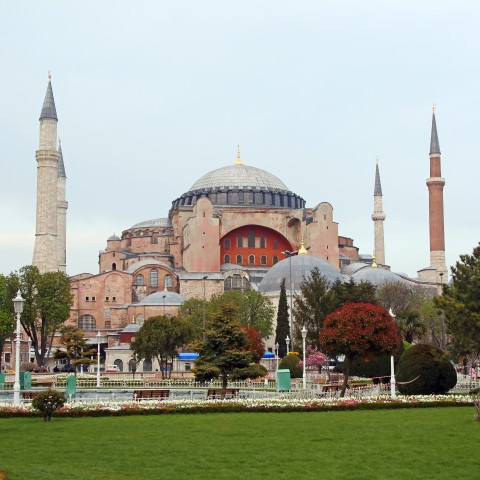
In 1931, the mosque became closed off to the public before reopening as a museum in 1935. This reopening was accomplished via the efforts of Mustafa Kemal Ataturk, the founder of the Turkish Republic.
According to the statistics provided by the Turkish Ministry of Culture and Tourism, Hagia Sophia was Turkey’s most-visited tourist place in 2015 and 2019. It was also placed on World Monuments Watch in 1996 and 1998.
In 2006, it became forbidden to use the Hagia Sophia as a place of worship, either as a mosque or a church. A small room was reserved for the Christian and Muslim staff to use as a prayer room.
There has been a lot of pressure from other world countries to convert it back to a church. Contrary to this, a new decision has very recently been made by the Council of Ministers to revert it to a mosque. It’s been said that the mosaics in the building will be preserved, but they will be covered with curtains, carpets, etc. during the prayers. It has also been declared that the doors of Hagia Sophia will always remain open to all Muslims and non-Muslims.
After this change, UNESCO will be re-evaluating the status of Hagia Sophia, which was on the World Heritage List.
2 – Topkapi Palace (Topkapı Sarayı)
Topkapi Palace is the palace where the Ottoman Empire was managed for about 400 of its 600 years. It’s also where the sultans lived and could accommodate about 4000 people at a time. Mehmet the Conqueror ordered its construction and it was built in 1478.
It was first used as a museum in 1924. When first established, it was on an area of approximately 700,000 m²; it now has an area of only 80,000 m².
It consists of hundreds of rooms and chambers, some of which are not open to visitors. A couple of the most interesting parts that are open to the public include the Ottoman Imperial Harem (where the sultan’s family would spend the day) and the treasury where the Spoonmaker’s Diamond and the Topkapi Dagger are displayed.
The palace has many amazing Islamic art pieces, hand-painted tiles, splendidly decorated rooms, and safeguarded towers. Is that all? Of course not! You’ll also find Ottoman garments, weapons, miniatures, and Islamic relics on display. Also, don’t forget to see the illuminated manuscripts (such as the Topkapi manuscript).
The palace is located within the Historic Areas of Istanbul, which was recognized by UNESCO as a World Heritage Site in 1985.
3 – Basilica Cistern (Yerebatan Sarnıcı)
This is the largest ancient cistern in Istanbul, and it’s located 490 feet (150 meters) southwest of the Hagia Sophia on the European side of Istanbul. It was built in the sixth century by the order of Byzantine Emperor Justinian I. There was previously a basilica located here, hence the name Basilica Cistern.
As one of the most fascinating museums in Istanbul, the Basilica Cistern has a ceiling supported by 336 marble columns and today has little water because it’s open to the public. There are two Medusa heads used as the bases of two columns. One head is sideways and the other one is upside-down. There’s no written record concerning these two Medusa heads.
The cistern is not only used as a museum, but also hosts many national and international events.
It was used as a location in the 1963 James Bond film From Russia with Love and was also featured in other movies. Furthermore, it was the subject of Dan Brown’s novel, Inferno.
Just a reminder: If you have asthma, it might not be suitable for you to visit this wonderful place due to the high humidity.
4 – Blue Mosque (Sultan Ahmet Camii)
The Blue Mosque was built between the years of 1609 and 1616 during the reign of Ahmet I. It’s located next to Hagia Sophia and is regarded as the last great mosque of the classical era.
It contains the tomb of Ahmet, a madrasah (a word which refers to any kind of educational institution), and a hospice. It’s called the Blue Mosque because its interior walls are decorated with hand-painted blue tiles. It has five major domes, six minarets, and eight secondary domes.

Its upper area is adorned with 20,000 hand-painted glazed ceramic tiles with sixty different tulip designs. The lower areas have 200 stained glass windows that are illuminated.
Many of the lamps inside the Blue Mosque were coated with gold and gems, but all of those items have either been taken out or stolen.
Pope Benedict XVI visited this mosque in 2006. It was considered an important event because this was only the second time in history that a pope visited an Islamic place of worship.
5 – Mosque of Suleyman the Magnificent (Süleymaniye Camii)
This mosque was ordered to be built by the Ottoman sultan Suleyman. Built at the highest end of the city to aggrandize the sultan, it was completed in 1557 by Mimar Sinan—the best engineer and architect of the time.
It has four minarets with ten galleries, representing that Suleyman the Magnificent was the tenth sultan of the Ottoman Empire.
It’s actually a complex that also has religious and cultural structures. Originally, it had the mosque, a hospital, public baths (hamam), a primary school, four Qur’an schools, a medical college, a Caravanserai, and a public kitchen where the poor people were served food. Many of these structures still exist, though the public kitchen is now a well-known restaurant and the hospital is the Turkish Army’s factory. Outside the mosque, you’ll also find the tomb of Mimar Sinan.
6 – Yedikule Fortress (Yedikule Zindanları or Yedikule Hisarı)
Yedikule Fortress means “Fortress of the Seven Towers.”
The Byzantine Emperor Theodosius wanted to welcome his visitors (kings, etc.) elegantly, so he wanted a Golden Gate to be built. His son, who inherited the throne after the death of Theodosius, had four towers built and had them combined with the Golden Gate.
After the conquest of Istanbul, three more towers were built at the order of Fatih Sultan Mehmet. Every one of these towers has a name.
Unfortunately, only some of the fortresses still exist today. There are about seventeen pieces (cannonballs, marble columns, etc.) displayed outdoors.
7 – The Galata Tower (Galata Kulesi)
Built in 1348 as Christea Turris (Tower of Christ in Latin), this is a high, cylindrical medieval stone tower that is cone-capped. It was the city’s tallest structure when it was built.
It underwent several restorations before becoming open to the public in 1960.
There are two elevators you can take to the upper levels, where there’s a restaurant and a café. The panoramic view of Istanbul and the Bosphorus from here is spectacular. There’s also a nightclub where you can watch a Turkish show and have a great time.
8 – Cruise the Bosphorus
If you would like to see more of Istanbul, you can have a cruise on the Bosphorus. Boats leave in the mornings and go toward the Black Sea. You can have your lunch at Anadolu Kavagi before walking up the hill to Yoros Castle for an amazing view. Just relax and enjoy the beauty of Istanbul!

9 – Grand Bazaar (Kapalıçarşı)
The Grand Bazaar is one of the largest covered markets the world over, and one of the oldest. As a matter of fact, it’s considered the first shopping mall in the world. Today, it’s one of the most famous attractions in Istanbul. It includes 61 covered streets, more than 4000 shops, and 26,000 employees.
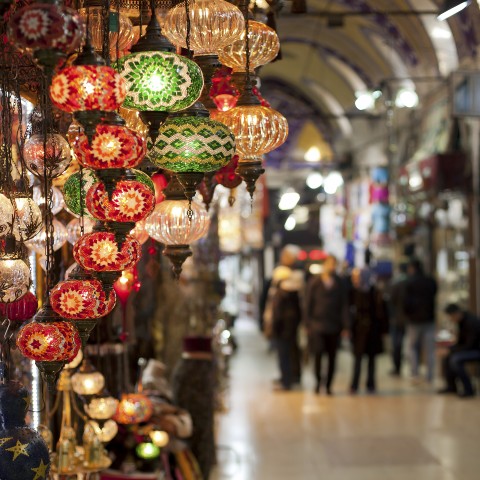
Its construction began not long after the conquest of Istanbul, in an attempt to revive the city’s economy.
For the past couple of years, the Grand Bazaar has been undergoing restoration.
10 – Spice Bazaar (Mısır Çarşısı)
The Spice Bazaar is the second most popular covered shopping area after the Grand Bazaar. You can buy Turkish delight, dried fruits, nuts, herbs, olives, and different kinds of spices. It now has a total of 85 shops in it.
There’s also a mosque called New Mosque (Yeni Camii) next to the bazaar. You might want to visit it while you’re in the area, so you can admire its tile-work and gold leaves.
Bonus
It’s impossible to talk about every point of attraction in Istanbul in just one article. But I did want to mention a few more places to visit in Istanbul if you have time:
- The Chora Church (Kariye Museum)
- Rustem Pasha Mosque
- Eyup Sultan Mosque
- Fatih Mosque
- The Hippodrome
- Dolmabahçe Palace
- Museum of Turkish and Islamic Arts
- Carpet Museum
- Pera Museum
In addition to these, you should also visit Ortakoy (a popular neighborhood) and Istiklal Street (a famous street of Istanbul).
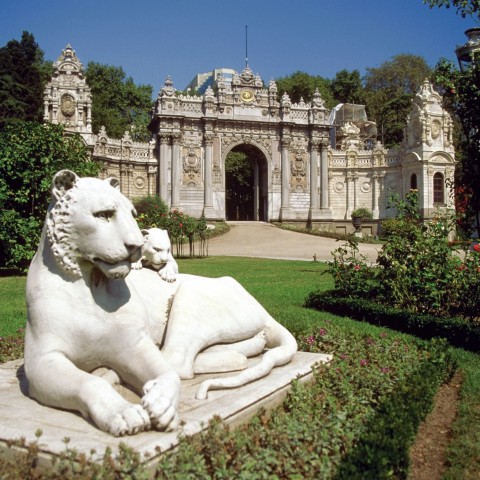
Turkish Survival Phrases for Travelers
Here are a few words and phrases that will help you communicate with locals while you visit Istanbul.
| English | Turkish |
| Hello. | Merhaba. |
| Goodbye. | Hoşçakalın. |
| Please. | Lütfen. |
| Thank you. | Teşekkür ederim. |
| Excuse me. | Afedersiniz. |
| Do you speak English? | İngilizce biliyor musunuz? |
| Can you help me? | Bana yardım edebilir misiniz? |
| I don’t understand you. | Sizi anlamıyorum. |
| Where is the restroom? | Tuvalet nerede? |
| How much is this? | Bu ne kadar? |
Learn More with TurkishClass101!
I hope this Istanbul travel guide gave you a much better idea of what to expect from this beautiful city and which spots you should definitely see. However, there’s still a lot more to know about the city, country, culture, and language!
You can get practical information on all these things by visiting TurkishClass101.com. We provide numerous audio recordings, tons of vocabulary lists, and free resources (including a Turkish-English dictionary you can refer to). In addition, our Premium PLUS members have access to MyTeacher—a feature that allows you to learn and practice with your very own personal tutor.
Interested? You can download the app for free and use it wherever you are.
By the way, which of these Istanbul locations are you most interested in seeing, and why? We look forward to hearing from you!

Are There Any English Words Used in Turkish?

When we’re learning a new language, it’s always a relief to find out that our target language uses a bunch of words from our native tongue.
The good news for you is that there are plenty of English words used in Turkish! Memorizing these words can give you a huge vocabulary boost with very little effort on your part and make the Turkish language seem a little less daunting.
In this article, you’ll learn about the most common English words in Turkish as well as the language phenomenon known as Turklish. We’ll even introduce you to several English words borrowed from Turkish to show you how deep the vocabulary exchange is between these two languages.
Let’s get started.
 Table of Contents
Table of Contents
- Introduction to Turklish
- English Loanwords in Turkish
- English Words of Turkic Origin
- Words with Similar Spelling / Pronunciation (But Different Meanings)
- Famous People, Franchise, and Movie Names in Turkish
- Learn More with TurkishClass101!
Introduction to Turklish
Although we will mainly talk about loanwords in this article, we’ll start by introducing you to the concept of Turklish (Türkilizce). This refers to native Turkish speakers using a mixture of Turkish and English words when speaking.
As we all know, English is the dominant language in almost all aspects of life, from science to technology. Hollywood movies have undoubtedly played a role in spreading the influence of English even farther.
There are around two million Turkish people living and studying in English-speaking countries such as the U.S.A., Canada, the U.K., and Australia. These people often use a combination of Turkish and English when communicating with each other—a phenomenon that came to be known as Turklish in 1994. Furthermore, it’s common for Turks who also speak English to use Turklish in corporate or international companies in Turkey.

Of course, Turkish linguists are opposed to the use of Turklish. They say it ruins the Turkish language and that people, especially those who use this new language hybrid within Turkey, do so just to evoke admiration and to sound more knowledgeable than they really are.
Here are a few examples of Turklish:
- Check etmek – To check
- Feedback vermek – To give feedback
- Cool görünmek – To look cool
- Download etmek – To download
- Spoiler vermek – To give away a spoiler
- Mail göndermek – To send mail
- Print etmek – To print
- Save etmek – To save
- Login olmak – To login
- Logout olmak – To logout
- Register olmak – To register
- Password’ü unutmak – To forget password
- Post etmek – To post

English Loanwords in Turkish
With the progress of technology and the growing popularity of social media, the use of English seems inevitable—even in countries where English is not an official language.
Aside from Turklish phrases like those mentioned above, there are also borrowed English words in the Turkish language that retain their original (or a similar) meaning and spelling. But while these words may look similar on paper, they’re normally pronounced according to Turkish phonology.
A lot of Turkish people (especially the younger generations) love to use these loanwords. Some might even do so because they think it will make them sound cool. However, linguists are not very happy about this situation.
Can you guess what any of these loanwords are? Let’s take a look.
Loanwords spelled exactly the same way
The list of English loanwords in Turkish is pretty long. The examples below have exactly the same meaning and spelling as their English counterparts, but the majority of them are pronounced differently.
Please note that on our list, you may also notice a few words that are not originally English—such as sauna (Finnish) and yoga (Sanskrit)—but which have become an integral part of the language over time.
| Atom | Holding | Mini | Plan | Silo |
| Bar | Ideal | Minimum | Poker | Salon |
| Banker | Jet | Net | Pop | Siren |
| Bravo | Kilogram | Normal | Printer | Slogan |
| CV | Laptop | Modern | Problem | Spiral |
| Depo | Latin | Motel | Program | Tablet |
| Diploma | Lens | Online | Protein | Taboo |
| Fan | Liberal | Organ | Radar | Tank |
| Film | Limit | Oval | Real | Trend |
| Final | Link | Park | Reform | TV |
| Form | Market | Partner | Risk | Video |
| Global | Metal | Patent | Robot | Vitamin |
| Gram | Meteor | Pedagog | Sauna | Yoga |
| Hamburger | Midi | Pilot | Set | Zebra |
Loanwords spelled differently
Below is a list of English words in the Turkish language with slightly different spellings than their English counterparts.
| English | Turkish | English | Turkish |
| Abnormal | Anormal | Active | Aktif |
| Academy | Akademi | Adaptation | Adaptasyon |
| Acetone | Aseton | Address | Adres |
| English | Turkish | English | Turkish |
| Action | Aksiyon | Advocate | Avukat |
| Actor | Aktör | Balcony | Balkon |
| Acid | Asit | Balloon | Balon |
| Acne | Akne | Bank | Banka |
| Bazaar | Pazar | Laser | Lazer |
| Cake | Kek | Mask | Maske |
| Card | Kart | Material | Materyal |
| Catalog | Katalog | Mission | Misyon |
| Comic | Komik | Negative | Negatif |
| Dance | Dans | Obese | Obez |
| Diesel | Dizel | Office | Ofis |
| Diet | Diyet | Panic | Panik |
| Discipline | Disiplin | Party | Parti |
| Editor | Editör | Project | Proje |
| Elastic | Elastik | Reference | Referans |
| Empathy | Empati | Score | Skor |
| Factor | Faktör | Service | Servis |
| English | Turkish | English | Turkish |
| Filter | Filtre | Technic | Teknik |
| Group | Grup | Tour | Tur |
| Hobby | Hobi | Unit | Ünite |
| Honor | Onur | University | Üniversite |
| Industry | Endüstri | Vision | Vizyon |
| Inventory | Envanter | Version | Versiyon |
| Jury | Jüri | Yacht | Yat |
| Kangaroo | Kangru | Zeppelin | Zeplin |
English Words of Turkic Origin
Now, let’s see the other side of the coin! This language exchange has gone in both directions, and there are several English words from Turkish.
Here are some Turkish words in the English language that have exactly the same meaning in both languages:
| English | Turkish | English | Turkish | English | Turkish |
| Aga/Agha | Ağa | Doner Kebab | Döner Kebap | Pastrami | Pastırma |
| Ayran | Ayran | Fez | Fes | Pilaf | Pilav |
| Bairam | Bayram | Kaftan | Kaftan | Seljuk | Selçuk |
| Baklava | Baklava | Kalpak | Kalpak | Shaman | Şaman |
| English | Turkish | English | Turkish | English | Turkish |
| Balkan | Balkan | Khan | Han | Shish Kebab | Şiş Kebap |
| Boza | Boza | Kismet | Kısmet | Tughra | Tuğra |
| Bulgar | Bulgar | Kurbash | Kırbaç | Turk | Türk |
| Bulgur | Bulgur | Kurus | Kuruş | Yogurt/Yoghurt | Yoğurt |
| Dolmush | Dolmuş | Pasha | Paşa | Yurt | Yurt |
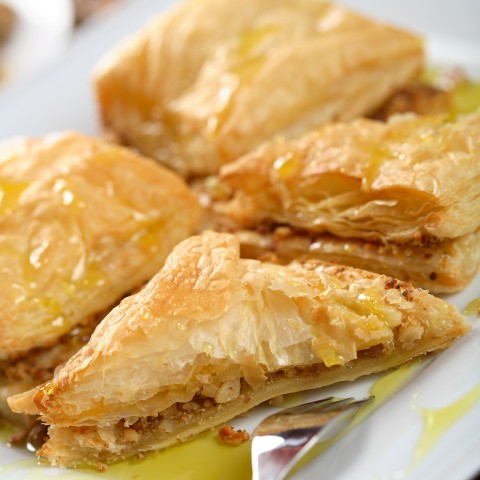
Words with Similar Spelling / Pronunciation (But Different Meanings)
Now let’s cover another interesting concept: words that are spelled or pronounced the same way in English and Turkish, but have completely different meanings. Learning these might help you remember certain Turkish words more easily!
Same Spelling, Different Meanings
The only thing these words have in common is that they’re spelled the same way in both languages. Other than that, their pronunciation (in most cases) and their meanings are different.
| English/Turkish | Meaning in Turkish | English/Turkish | Meaning in Turkish |
| An | Moment | Mum | Candle |
| At | Horse | Nine | Grandma |
| Can | Life | On | Ten |
| Cam | Glass | Pat | Aster |
| English/Turkish | Meaning in Turkish | English/Turkish | Meaning in Turkish |
| Fare | Mouse | Post | Fleece |
| Gel | Come | Pot | Blunder |
| Gem | Bit | Saf | Pure |
| Gene | Again | Seven | Loving |
| Ham | Raw | Son | Final/Last |
| Hat | Line | Sun | Offer |
| Her | Every | Sure | Sura |
| His | Feeling | Tan | Dawn |
| Men | Preclusion | Ten | Skin |
| Mine | Enamel/Verbena | Top | Ball |
Same Pronunciation, Different Meanings
The following words are pronounced the same way, but have different meanings and spellings:
| English | Turkish | Meaning in Turkish | English | Turkish | Meaning in Turkish |
| Car | Kar | Snow | Pick | Pik | Peak |
| Cut | Kat | Floor/Layer | Tape | Teyp | Stereo/Cassette Recorder |
| English | Turkish | Meaning in Turkish | English | Turkish | Meaning in Turkish |
| Cup | Kap | Container | Tick | Tik | Twitch/Teak |
| I | Ay | Moon | Top | Tap | Worship/Adore |
Famous People, Franchise, and Movie Names in Turkish
All proper names are written in Turkish just as they are in English, though they may be pronounced differently. Examples include:
Brand Names
- Nike
- Skechers
- Nine West
- Calvin Klein
- Levi’s
Food Chains
- McDonald’s
- Burger King
- Subway
- Starbucks
- Arby’s
Celebrities
- Johnny Depp
- Julia Roberts
- Clint Eastwood
- Halle Berry

Series and movie names, however, are usually translated into Turkish. This is probably for commercial reasons, as marketers try to come up with Turkish names that will appeal to the culture and draw more attention so they can get higher ratings and make more money.
Here are some examples you might find interesting:
| Name of the movie | Translated into Turkish |
| Mission Impossible | Görevimiz Tehlike (Our Mission is Danger) |
| Two for the Money | Kirli Para (Dirty Money) |
| A Beautiful Mind | Akıl Oyunları (Games of the Mind) |
| Rush Hour | Bitirim İkili (Crack Couple) |
| Sliding Doors | Rastlantının Böylesi (Such a Coincidence) |
| Name of the movie | Translated into Turkish |
| Sweet November | Kasım’da Aşk Başkadır (Love is Different in November) |
| Good Will Hunting | Can Dostum (My Best Friend) |
| Suicide Squad | Gerçek Kötüler (Real Villains) |

Learn More with TurkishClass101!
Now that you’ve learned all of these English words used in Turkish, we hope that learning the language won’t be so daunting for you anymore. To make your language learning process even smoother and more worry-free, continue exploring TurkishClass101.com!
We provide an array of practical learning materials, including numerous audio recordings, tons of vocabulary lists, and free resources (including our Turkish-English dictionary). It’s our aim to help you master the language and get a feel for the culture.
Don’t forget that you can also sign up for a Premium PLUS account to use our MyTeacher service, which will allow you to learn and practice with a private teacher.
Best of all, you can download the app for free and use it wherever you are.
Before you go, let us know in the comments if any of the words on our list surprised you or if you have any questions. We look forward to hearing from you!

A Brief Overview of Turkish Culture and Traditions

Turkey is a country straight from the depths of history, with empires dating back 4000 years. The course of time and events has introduced Turkey to a range of peoples and cultures, lending this great country a rich culture full of unique traditions and customs.
In this lesson, you’re going to learn all about Turkish culture and traditions. We promise this will be a very colorful, out-of-the-ordinary experience for you!
 Table of Contents
Table of Contents
- Core Values
- Ethnicity and Religion
- Traditions in the Flow of Life
- Social and Business Life
- Handcrafts and Art
- Traditional Turkish Holidays
- Other Cultural Highlights
- Final Thoughts
1. Core Values
I believe every culture promotes core values such as honesty, justice, fairness, equality, and so on. However, most of these values are dependent upon the conscience, one’s inner person—there will always be people who stick to these values and those who don’t. Of course, these are only exceptions to the rule.
In addition to these common core values, there are others that may be unique within a country or central to its identity.
For example, elderly people have a special place in Turkish people’s lives and are treated with great respect. The concept of family is considered sacred and neighborliness is very important. Relations with neighbors are so close and sincere that it’s very common for a neighbor to knock on another’s door and ask if they have a cup of sugar or flour to give him or her.
In Turkish culture, hospitality is another distinguished value. Especially in rural areas, the host or hostess will share their last slice of bread with a stranger. They love offering food and drinks to friends, neighbors, acquaintances, and even strangers. They also love to help people in need, whether individually or as a nation. When a disaster happens somewhere, people start donating money, sending equipment, and so on, without hesitation.
Most Turkish women are obsessed with the cleanliness of their houses. They have to be clean all the time. If you ever visit a Turkish home, don’t forget to take your shoes off. Most families will expect you to do so!
There is a strong sense of patriotism in the country. This shouldn’t be a surprise, since we have a great role model: Atatürk, one of the best leaders of all time. Turks always try to be loyal to their historical heritage.
The Turkish flag and the national anthem are highly respected. The flag is never put on the floor or the ground and whenever the national anthem is sung somewhere, people passing by will stop, stand by attention, sing along, and continue on their way when it’s over.
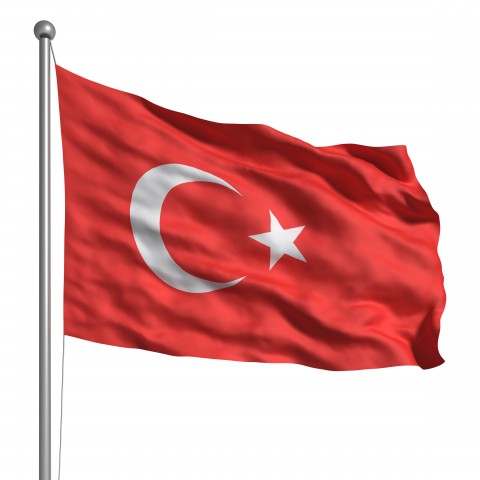
2. Ethnicity and Religion
Turkish culture and customs are largely influenced by the country’s ethnic diversity, as well as the strong religious nature of the Turkish people. Take a look.
A- Ethnicity
Considering that Turkish history goes back thousands of years—and that the Ottoman Empire, which controlled Southeastern Europe, some parts of Eastern Europe, Western Asia, and Northern Africa, played a role in recent history—it’s not surprising that Turkey is home to many ethnicities. 75% of its population consists of Turks, 18% consists of Kurds, and the remaining 17% consists of other ethnic groups, which include:
- Afghans
- Albanians
- Arabs
- Armenians
- Australians
- Azerbaijanis
- Bosniaks
- Bulgarians
- Circassians
- Crimean Tatars
- Dutch
- Georgians
- Germans
- Greeks
- Iranians
- Kazakhs
- Kyrgyz
- Levantines
- Russians
- Serbs
- Turkmens
- Uzbeks
There have been many marriages between Turks and these ethnic groups. Therefore, some aspects of these different cultures have become intertwined with the fibers of traditional Turkish culture.
B- Religion
99% of the country is Muslim. Christianity, Judaism, Yezidism, and others make up the remaining 1%.
The diversity of ethnic groups and religions play an important role in our culture. This cultural diversity in Turkey has led Turkish people to have more respect for other cultures, traditions, religions, and ideas.
- → Does this topic interest you? Then head over to our Religion vocabulary list to learn the names of different religions in Turkish!
3. Traditions in the Flow of Life
There are several Turkish traditions regarding major life events. Let’s take a look at how the Turkish treat such events as marriage, birth, and death.
A- Marriage
In the past, marriage was considered sacred and arranged marriages were popular. However, due to the increasing number of divorces, this sacred view of marriage is questionable these days. As for arranged marriages, they may still be popular in smaller cities or rural areas but not so much in big cities.
There are formalities to go through before one can get married.
First of all, the groom and his family have to visit the bride’s family to receive permission for the marriage. They bring flowers and a box or bowl of chocolate, and the bride makes them Turkish coffee. Then, the groom’s father or an elderly male from the family asks the bride’s father if he would approve the marriage.
The answer is “Yes” most of the time, unless it’s an arranged marriage. In that case, the answer may be “We will think about it,” because in an arranged marriage, the bride’s family may not know the groom and his family. Because the proposal might have been somebody’s recommendation or referral, the father might need time to check on the groom before deciding whether to approve the marriage or not.
If the answer is “Yes,” then it’s considered a “promise” and “promise rings” are put on the fingers of the couple by somebody from the bride’s family. This is followed by an engagement ceremony at a later date.
The trousseau concept is also popular in Turkish culture. The trousseau is usually exhibited to the guests for a few days in the bride’s home and then about a week prior to the wedding, it’s taken from there to the groom’s house.
Bridal Bath
There is an ancient tradition called “bridal bath” (gelin hamamı), which is not that common these days, though it may still be performed in some parts of Turkey. According to this tradition, the bride and her female relatives and friends go to a Turkish bath (Türk hamamı). The bride sits in a higher position while her maidens walk in a circle around her carrying candles. They sing and spend the day there.
Henna Night
This is usually held the night before the wedding. It’s kind of like a bachelorette party, also celebrated by the bride and her female relatives and friends. It’s usually held at the bride’s parents’ house, though some people prefer to rent a place if they plan to invite quite a number of people.
You may be wondering what it has to do with “henna.” Well, henna is applied to the bride’s hands and guests who are eager to have it will also put henna on their palms.
Wedding
In Turkish culture, wedding traditions vary based on region. Here, I’ll only talk about the most common ones.
On the wedding day, the car for the soon-to-be newlyweds is decorated. The groom, along with his family, goes to the bride’s house to pick her up. This event is usually accompanied by a few instrumentalists playing the drum and the zurna.
The solemnization of the marriage can be performed at one of the municipality’s wedding halls with guests. After that, there can be a dinner party or an after-dinner party someplace else. Or, both the solemnization and party can be at a venue other than a wedding hall.
After the couple is announced as husband and wife, there is a gift-giving ceremony. Guests give gold coins, gold bracelets, and other types of jewelry as a gift to the couple.
B- Birth
As in other cultures, Turkish culture perceives birth as an event for joyous celebration. After the baby is born, people come to see the baby and bring presents or gold coins that have a blue or pink bow attached to them. Close family members also bring presents and gold bracelets for the mother.
C- Death
If the deceased person is Muslim, the first farewell will take place in a mosque. Then, people go to the cemetery for the burial. Those who go to the cemetery are invited to the house of the person who died and are offered lunch or dinner depending on the time of day. Neighbors, family members, and acquaintances bring food to the family who suffered the loss.
4. Social and Business Life
What does the average day look like in Turkish society? Here’s some practical information on what to expect from day-to-day social interactions and work life in Turkey.
A- Social Life
Turkish people are social and they love doing things together. Because the Turkish enjoy sharing life’s experiences with others, you’ll often find large groups of people out hiking, dining, or engaging in any number of activities. This is especially true in the summertime. This is when you can see a lot of people socializing at cafes, restaurants, and bars until late hours, even during the week.
Turks require less personal space than most people do. So if a Turk stands close to you while conversing, don’t be surprised.
B- Business Life
Business relationships are usually formal. Turks prefer to work with people they know and trust. Therefore, if you need to do business with a Turkish company, you need to establish a good relationship with them.
If you’re having a meeting with Turkish people, make sure not to use their first names. Rather, call them Mr. X or Ms. Y. Furthermore, men should wear a suit and tie; women should also wear a professional-looking outfit. Especially in smaller cities, you need to be careful about what you wear as some places are conservative.

Here are a few other aspects to note about Turkish work culture:
- ★ Decision-making can be slow sometimes
★ Family owned and run businesses are usually more conservative
★ Turkish people love negotiating, not only in business, but also individually when shopping
If you plan on working in Turkey, you will need some basic vocabulary down first. To get a head start, you can visit our vocabulary lists on Jobs / Work and The Workplace.
5. Handcrafts and Art
After food, perhaps one of the most exciting things about Turkish culture for tourists is the vast array of artforms to view. Let’s briefly look at the most popular types of handcrafts and art forms in Turkey!
A- Handcrafts
Throughout history, Turkish people have learned to create many different handcrafts. Here are a few that have sprouted from the cultural diversity in Turkey:
- Carpet and rug weaving
- Mother of pearl inlaid
- Filigree
- Ceramics and tiles
- Pottery-making
- Marbling (ebru)
- Calligraphy
- Coppersmithing
- Miniature work
- Glass work
- Embroidery
- Leather tanning
- Meerschaum
- Xylography
B- Art
Turkey has world-renowned artists in almost every branch of art. For example:
Yasar Kemal is a famous author whose novels have been translated into numerous languages. Orhan Pamuk is a Nobel Prize-winning author. Nuri Bilge Ceylan is a world-renowned movie director who has many awards. Tan Sağtürk is an internationally acknowledged dancer.
Here are some other artists who are well-known globally:
- ★ Fazıl Say (pianist and composer)
★ Genco Erkal (stage actor)
★ İdil Biret (pianist)
★ Güher-Süher Pekinel (pianist)
★ Abidin Dino (artist and painter)
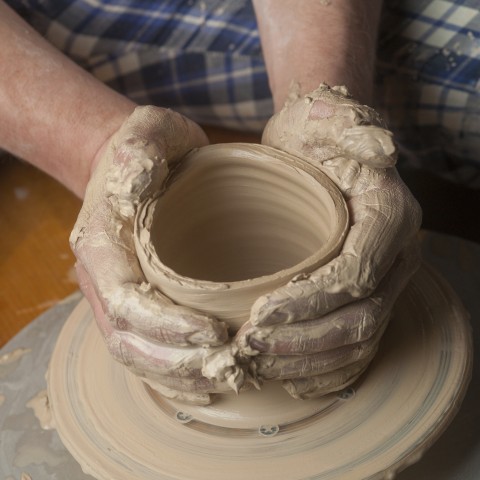
6. Traditional Turkish Holidays
Like in other cultures, holidays are a huge part of the Turkish culture and lifestyle. Turkish people celebrate two types of holidays: national and religious.
A- National Holidays
There are several national holidays in Turkey throughout the year, including:
- Republic Day (October 29)
- Youth and Sports Day (May 19)
- National Sovereignty and Children’s Day (April 23)
- Victory Day (August 30)
During the national holidays, all official offices are closed and the cities are decorated with Turkish flags. You can also see flags hanging from the windows and balconies of houses and offices.
B- Religious Holidays
There are two moveable religious holidays every year.
Ramadan
Ramadan is the month when Muslims fast for thirty days, between the sunrise and the sunset of each day. A three-day holiday follows the month of Ramadan. During this holiday, people visit other family members, friends, etc. Younger ones kiss older ones’ right hand and then put it on their own foreheads; this is a symbol of respect. Candy, chocolate, and Turkish coffee are offered to visitors, and children are given money as allowance.
The Feast of Sacrifice
This holiday is four days long. Most households, if they can afford it financially, sacrifice an animal (usually a sheep) in a special ritual. The meat is shared with relatives and neighbors, with one third of the meat usually given to those who are in need. In addition to these special traditions, the same features of the Ramadan holiday apply to this one.
7. Other Cultural Highlights
To conclude, let’s go over a few more Turkish culture characteristics you should be familiar with before visiting the country!
A- Food and Beverages
Turkey’s food culture is a major component of both daily life and special occasions. I’m sure you’re already well aware of the grand reputation Turkish cuisine has made for itself, so I’ll only list some of the most outstanding food and drink items here. But if you would like to know more about Turkish food, you can visit our lesson “How is the Turkish Food?“
- Döner kebap. This is seasoned meat cooked on a vertical rotisserie.
- Yaprak sarma. This consists of grape leaves stuffed with spicy rice or spicy ground meat.
- Baklava. This famous Turkish dessert is something that I highly recommend.
As for beverages, rakı is an alcoholic beverage which is consumed quite a bit in Turkey. It is similar to ouzo.
Another thing I should mention is that Turkish tea culture is alive and well! Turkish people drink tea many times a day, and anytime of day!
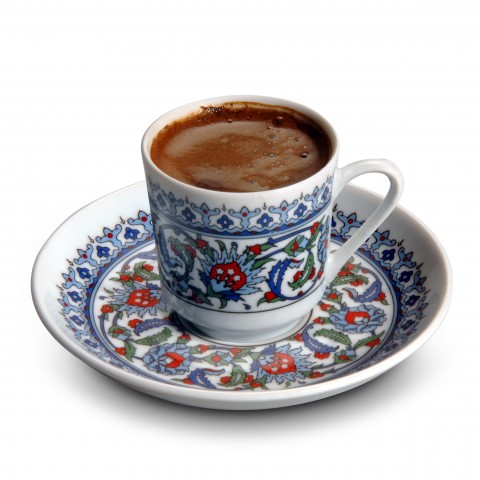
Turkish coffee is another big part of the culture. It’s usually preferred after meals. While talking about Turkish coffee, I must also mention coffee cup reading: usually, when women get together and drink coffee, they ask each other to do the cup reading. It’s a lot of fun to make sense of the shapes formed from the coffee grout.
B- Gestures
Turkish people use quite a number of gestures. Let me just give you a few examples:
1. If a person puts his/her fingers together with the thumb and moves the hand back and forth, it means “good” or “delicious.”
2. Raising the chin up, sometimes with the eyebrows up, means “no.”
3. If a person holds his/her hand next to his/her head and moves the hand like they’re unscrewing a light bulb, then he/she is calling someone “crazy.”
C- Superstitions
Here are just a few Turkish superstitions:
1. Turkish people are usually concerned about being coveted. However, people believe that a blue bead called nazar boncuğu protects them from ‘evil eyes.’ These beads are used in homes, offices, and cars, and are also used as a decorative object. Furthermore, they are used on earrings, necklaces, bracelets, and other forms of jewelry.
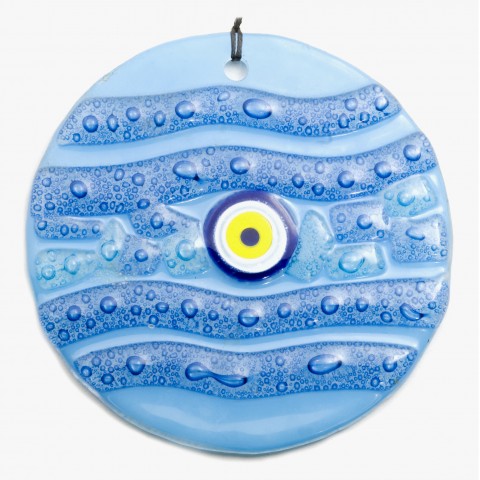
2. Some people believe seeing a black cat brings bad luck.
3. Some think a broken mirror brings seven years of bad luck.
8. Final Thoughts
In this lesson, you learned a variety of useful Turkish culture facts. But there’s a lot more to know!
To get a better grasp of the Turkish language and culture, visit TurkishClass101.com. We provide numerous audio recordings, tons of vocabulary lists, and other free resources including a Turkish-English dictionary for easy reference.
By signing up for a Premium PLUS account, you can also take advantage of our MyTeacher service. You’ll be able to study and practice with your own private tutor, who will give you assignments, answer questions, and help you improve your pronunciation.
Download the app for free and use it wherever you are.
Before you go, let us know in the comments how Turkish culture compares to that in your country. We look forward to hearing from you!

A Tasty Guide to Traditional Turkish Food

If you’re interested in different flavors and after some really delicious food, then you must be aware of Turkish food’s reputation as one of the tastiest cuisines worldwide.
Turkish cuisine is influenced by the Ottoman Empire. It’s known for its variety and its amazing flavor, and the foods you can expect to find varies based on region. While some regions have their own unique dishes, there are plenty of cases where those same dishes are made with different ingredients (or even different techniques) in other regions.
In this article, we’ll cover several Turkish foods that are worth tasting as well as a simple recipe you might want to try at home. Keep in mind that due to the cultural richness of Turkish cuisine, it’s impossible to mention all of the traditional Turkish foods here. You should consider finding a good Turkish cuisine restaurant near you to see—and try!—an even greater variety of dishes.
Are you ready to hear about all the mouthwatering food that awaits you?
 Table of Contents
Table of Contents
- The 5 Best Turkish Foods to Try
- A Typical Turkish Breakfast
- Delicious Turkish Pastries
- Kebabs and Meat Dishes
- A Variety of Appetizers
- Vegetable Dishes
- Yummy Desserts
- Food-Related Vocabulary
- A Delicious Turkish Food Recipe
- Final Thoughts
1. The 5 Best Turkish Foods to Try
I had to think hard about what to include here—not because there aren’t many good foods to pick from, but because there are so many wonderful Turkish cuisine dishes out there!
A- Mantı
This is the specialty of Central Turkey, and it’s originally from a city called Kayseri.
Mantı is like miniature ravioli stuffed with meat, but it tastes a bit different. It consists of small boiled handmade dumplings filled with ground meat. It’s served topped with yogurt, garlic, chili powder, and melted butter. Some people prefer to add ground sumac and dried mint, as well.
B- Döner Kebap
This consists of seasoned meat cooked on a vertical rotisserie (also called a rotating spit). Actually, döner means “rotates.” The meat is sliced into long, thin strips and can be served in different forms:
- Served on a plate on top of sliced pita bread with melted butter over it.
- Served on a plate on top of sliced pita bread with tomato sauce, yogurt, and melted butter over it. This is called İskender Kebap.
- Wrapped in a lavash with tomatoes, lettuce, and onion. This is called dürüm.
C- Yaprak Sarma
Sarma means “wrapping,” and this popular Turkish dish is basically grape leaves stuffed with spicy rice or spicy ground meat. The rice version is cooked with olive oil and served cold, while the ground meat version is served hot. It’s usually accompanied by yogurt at the table.
Preparation of yaprak sarma takes quite a bit of time, but it’s definitely worth it.
D- Çiğ Köfte
Çiğ köfte consists of spicy patties made of ground beef, fine ground bulgur, onion, pepper, tomato paste, spices, and herbs. The vegetarian version is made without meat. This dish is popular in the southern part of Turkey.
E- Künefe
This is a very rich dessert. Fortunately, it’s pretty difficult to make at home, so it’s not something you can eat all the time!
It’s made of shredded pastry dough (bread crumbs) and cheese, then topped with pistachio nuts.
2. A Typical Turkish Breakfast
Now, here comes my favorite meal. Would you like to join me in setting the table for breakfast?
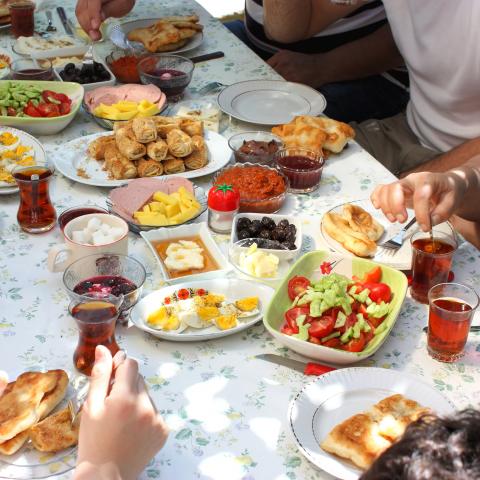
Let’s open the fridge and take out the following:
- Butter
- Cheese
- There are three preferred types of Turkish cheese: white (feta) cheese, tulum cheese, and kaşar cheese.
- Olives
- Black and/or green olives can be found at most Turkish breakfast tables.
- Tomatoes and cucumbers
- Jam
- Most people make their jams at home. You can’t imagine the variety of jams we have: sour cherry, peach, apricot, orange, strawberry, quince, fig, bergamot…we even have watermelon, walnut, eggplant, and rose jams!
- Eggs
- They can be boiled, omelet-style, or menemen. Menemen is basically scrambled eggs cooked lightly with tomatoes, onions, and peppers.
Bread—usually toasted or freshly baked—is another popular Turkish food for breakfast, though some people prefer different pastries. For example, simit (round dough covered with sesame seeds) and poğaça (containing cheese, olives, potatoes, etc.) are two other common pastries in Turkey.
Another ‘must’ at the table: Tea. Tea is definitely a huge part of Turkish food culture!
3. Delicious Turkish Pastries
Here are some Turkish pastries most people have a hard time saying no to:
A- Börek
Börek is the generic name for pastries made with yufka, which is like filo dough.
This pastry is made up of thin layers of dough. The yufka for börek can be handmade or bought from a Turkish food market. Börek can have different ingredients in it (such as cheese, ground meat, spinach, or potatoes) and it can also come in different shapes (rolled, layered, etc.). Depending on its form, its ingredients, and the way it’s baked, it might have different names. For example:
- sigara böreği
- çiğ börek
- su böreği
- kol böreği
This pastry can be served during any meal, as a snack, or at tea time.
B- Gözleme
First, a lavash bread is made. Then, fillings such as cheese, spinach, ground meat, and potatoes are placed on it and the bread is folded over the filling. It’s then baked on a large metal sheet, called a sac.
C- Pide
Pide is made of dough and filled with cheese, ground meat, or small cubes of seasoned meat. Some people describe it as being boat-shaped, which is a good way to picture it. This pastry is usually eaten in a restaurant, not made at home.
D- Lahmacun
This is thin dough covered with a layer of spiced ground meat, tomatoes, peppers, and onions. Again, this is something we usually eat at a restaurant.
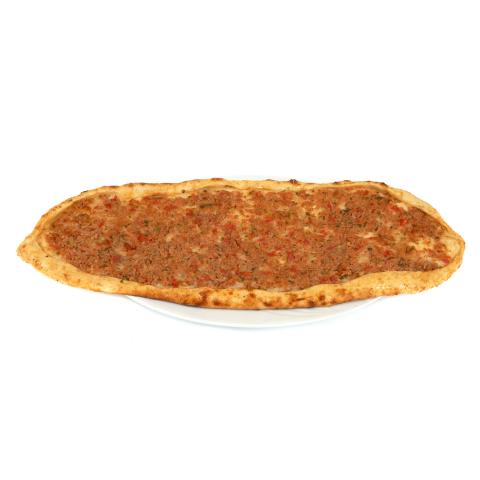
E- Katmer
Katmer is a rolled-out dough which can be sweet or salty depending on its filling.
4. Kebabs and Meat Dishes
Do you enjoy the succulent flavors of meat dishes? If so, here are some foods in Turkey you absolutely need to try!
A- Kebabs
Attention meat-lovers: Get ready for all of these delicious kebabs.
There are many different types of kebabs, originating from all over Turkey. Each type is made with meat, but the similarities end there. The seasonings, cooking methods, and non-meat ingredients all differ, and they can come in various shapes. Here are the most popular ones:
- Adana kebap
- Beyti
- Çağ kebabı
- Çöp şiş
- Kağıt kebabı
- Orman kebabı
- Talaş kebabı
- Tandır kebabı
- Tas kebabı
- Urfa kebabı
B- Meatballs
“Meatball” is köfte in Turkish. Meatballs are made of ground meat, and there are several unique varieties named after their city of origin. For example:
- İzmir köfte
- Manisa köfte
- İnegöl köfte
Other types of meatballs include:
- Kasap köftesi
- Dalyan köfte
- Misket köfte
C- Veggies with Meat
Here are a few Turkish dishes that contain a hearty dose of veggies along with the tasty meat.
Karnıyarık
This consists of baked eggplants filled with ground meat, seasonings, and parsley, then covered in a tomato sauce.
Hünkar beğendi
This dish was inherited from the Ottoman Empire. It’s basically soft, marinated lamb cubes served on top of an eggplant, which is pureed with butter and melted kashar cheese.
Etli dolma
Dolma is a dish where vegetables such as bell peppers, eggplants, tomatoes, and zucchinis are stuffed. They may also be stuffed with spicy rice or ground meat. This is another dish inherited from the Ottoman Empire.
Etli taze fasulye
This is basically green beans cooked with tomato paste, ground meat, and onions.
And that’s not all! There are plenty of Turkish meat-and-veggie dishes you can try. Just search online for some Turkish food recipes to discover more dishes like these.
5. A Variety of Appetizers
“Appetizer” is meze in Turkish, and Turkish cuisine features a very rich appetizer selection. I’ll mention just a few of them here.
- Acılı ezme: Made with mashed tomato with hot spices, onion, and green herbs
- Patlıcan salatası: Made with roasted eggplants, yogurt, and garlic
- Fava: Made with fava beans
- Kısır: Made with fine ground bulgur, tomato paste, onion, parsley, garlic, sour pomegranate juice, and spices
- Piyaz: Made with white beans, onions, and vinegar
- Cevizli biber: Made with red peppers, onions, pepper paste, and walnut
6. Vegetable Dishes
Vegetarians, are you still with me? Don’t miss out on these yummy veggie dishes.
Let me start with a very generic recipe. There’s a general term used to describe vegetables cooked with olive oil: zeytinyağlılar. To make this, green beans, peas, zucchinis, and kidney beans are cooked with tomatoes, onions, and olive oil. It’s served cold.
Now, let me list some more Turkish food for vegetarians:
- Baklalı enginar: Made with artichokes and fava beans; usually made in the summer
- Pırasa yemeği: Made with leeks, carrots, and rice
- Borani: Made with spinach, onions, yogurt, and garlic
7. Yummy Desserts
Now, here comes my favorite topic: delicious desserts!
A- Baklava
Baklava is probably the most popular and internationally recognized Turkish dessert. It’s made with handmade filo dough and consists of several layers. It contains chopped walnuts or pistachios, as well as syrup.
B- Güllaç
The history of güllaç goes back to the Ottoman Empire, and it’s usually served during Ramadan. It consists of thin and large dough layers, which are soaked in milk and rose water, and served with walnuts and pomegranate seeds.
C- Kazandibi
This is like a milk pudding, but the bottom part of it is burnt. This is another dessert inherited from the Ottoman Empire.
D- Aşure
This one is like a dense, sweet soup. It contains boiled beans, wheat, dried fruits, nuts, cinnamon, chestnuts, and rose water. There’s a legend about this dessert, according to which it was made for the first time on Noah’s Ark with seven different ingredients.
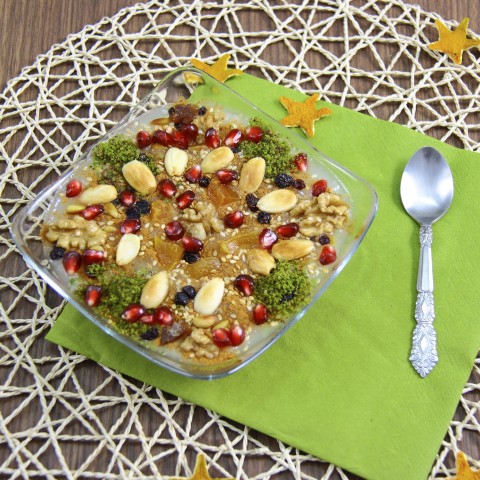
8. Food-Related Vocabulary
After learning about so many dishes, how about diving into a little Turkish food vocabulary?
A- Talking About Food
- En sevdiğim yemek köftedir. (“My favorite food is meatballs.”)
- Ben maydanoz sevmem. (“I don’t like parsley.”)
- Ben vejeteryanım. (“I’m a vegetarian.”)
- Çileğe alerjim var. (“I’m allergic to strawberries.”)
- Karnım acıktı. / Ben açım. (“I’m hungry.”)
- Karnım tok. / Ben tokum. (“I’m full.”)
- Açlıktan ölüyorum. (“I’m starving.”)
B- Terms for Cooking
Here are some words used during food preparation!
Actions
- Pişirmek (“To cook”)
- Fırında pişirmek (“To bake”)
- Kızartmak (“To fry”)
- Kesmek (“To cut”)
- Dilimlemek (“To slice”)
- Soymak (“To peel”)
- Doğramak (“To chop”)
- Rendelemek (“To grate”)
- Karıştırmak (“To mix”)
Ingredients
- Et (“Meat”)
- Sebze (“Vegetable”)
- Meyve (“Fruit”)
- Yağ (“Oil”)
- Su (“Water”)
- Tuz (“Salt”)
- Baharat (“Spice”)
- Un (“Flour”)
- Şeker (“Sugar”)
Utensils
- Çatal (“Fork”)
- Kaşık (“Spoon”)
- Bıçak (“Knife”)
- Tencere (“Cooking pot”)
- Tava (“Frying pan”)
- Ocak (“Range”)
- Fırın (“Oven”)

C- How to Order at a Restaurant
Finally, here’s how to order Turkish food at a restaurant:
- Menüyü görebilir miyim? (“May I see the menu?”)
- Ne önerirsiniz? (“What would you recommend?”)
- Su alabilir miyim lütfen? (“May I have water, please?”)
- Bu sos acı mı? (“Is this sauce spicy?”)
9. A Delicious Turkish Food Recipe
Hold on now, here comes a simple recipe for you to try making at home!
Let’s make a quick appetizer called havuçlu meze:
Ingredients:
- 4 medium carrots (peeled and grated)
- 500g yogurt
- 2-3 cloves of garlic (peeled and grated)
- ¼ bunch dill (chopped)
- 2 tbsp. of olive oil
- Salt (eyeball it)
Instructions:
1. First, heat the olive oil in a frying pan and then add the grated carrots.
2. Sauté them on medium heat until they soften.
3. Then add salt and stir.
4. Remove it from the range and let it cool.
5. Mix garlic and yogurt.
6. When the grated carrots are cooled, add your garlic yogurt and dill to it. Mix it altogether.
7. You can decorate it with parsley leaves before serving.
10. Final Thoughts
In this article, you learned about traditional Turkish food and some practical food-related vocabulary.
Which Turkish food do you want to try most, and why? Have you already tried some of the foods we mentioned? We look forward to hearing from you!
To get a better grasp of the Turkish language and culture, explore TurkishClass101.com and take advantage of our numerous audio and video lessons, themed vocabulary lists, and free resources (including this dictionary). If you have a Premium PLUS account, you can also learn and practice with a personal tutor using our MyTeacher service! And don’t forget to download the app for free so you can study anywhere, anytime.
Until next time, happy eating!

A Quick Turkish Grammar Guide

Let me look into my magic crystal ball and tell you what I see… You’re interested in learning Turkish or have just started working on it. You’re curious to know what Turkish grammar looks like and whether it’s similar to English grammar. And actually, you’re dying to learn what kind of an adventure you’re getting yourself into.
Of course, I’m not a fortune teller. But if I guessed correctly, you’re at the right address. This page serves as an overview of Turkish, an essential grammar guide, and a quick reference for those who want to brush up on specific grammar topics.
Our quick guide will show you the similarities and dissimilarities between Turkish and English as well as the basic structure of Turkish grammar, from vowel harmony to conjugation.
Let’s get started.
 Table of Contents
Table of Contents
- General Overview
- Word Order
- Word Structure and Agglutination
- Suffixes, Vowel Harmony, and Buffers
- Possessives
- Verbs and Conjugation
- Access More Turkish Grammar Content on TurkishClass101.com
1. General Overview
Before we get into the details, it’s important that we cover the basic Turkish grammar rules and how they compare to those you’re familiar with in English.
Similarities
First of all, both languages use the Latin alphabet. The Turkish alphabet, however, consists of 29 letters, 6 of which don’t exist in English ( -ç, -ğ, -ı, -ö, -ş, -ü). There are also 3 letters in English (-q, -w, -x) that don’t exist in the Turkish alphabet.
There are a few words that exist in both Turkish and English that have the same meaning:
- ➢ TV
➢ Plan
➢ Program
➢ Market
➢ Silo
➢ Video
Like English, Turkish also uses the indefinite article in front of nouns as a separate word:
- ➢ Bir araba (“A car”)
➢ Bir otel (“A hotel”)
In addition, neither Turkish nor English uses grammatical gender for objects.
It’s safe to say that there are no accent marks in English, since the words that have them are taken from other languages. There are no accent marks in Turkish, either.
However, the circumflex is used for some loanwords. It affects the pronunciation of a word by implying that the word’s pronunciation should be longer or that there should be palletization of the consonant that comes before the vowel.
For example: “Âmâ” is an Arabic word that means “blind.” The circumflex here makes both of the “a” sounds longer. There’s another word, “ama,” which means “but.” Although they are spelled the same way (except for the circumflex), those two words are pronounced differently.
Dissimilarities
Now let’s take a look at the features of Turkish grammar that differ from English.
Pronouns
There’s just one word used in Turkish for “he,” “she,” and “it,” which is o.
In Turkish, the plural “you” is not only used as it is in English, but also as a polite, formal way of addressing someone. The same set of rules apply to both the plural “you” and the polite “you” in Turkish.
The Definite Article
Turkish has no definite article (“the”) as a separate word. When definite nouns or pronouns are used as an object, then they take the “-ı, -i, -u, -ü” suffixes based on the vowel harmony rules. Let me give you an example:
- ➢ Anahtarlar çantamın içinde. (“The keys are in my purse.”)
Here, “keys” is used without an article.
- ➢ Anahtarları çantamın içine koydum. (“I put the keys in my purse.”)
Here, “keys” takes the suffix -ı to indicate the definite article.
Numbers as Adjectives
When numbers are used as adjectives to count nouns, the noun does not become plural based on the number. Rather, it stays in the singular form. Here’s an example:
- ➢ Bir elma (“One apple”)
➢ Beş elma (“Five apples”)
Word Order
The Turkish word order is Subject-Object-Verb. This topic will be covered in more detail later.
Vowel Harmony and Suffixes
Vowel harmony is another feature that doesn’t exist in English. You can see the details about this in the “Suffixes, Vowel Harmony, and Buffers” section of this page.
Conjugations
The conjugation in Turkish is much different from that in English, which we’ll discuss in more detail later on in the “Verbs and Conjugation” section. But to give you an example, there’s a tense called “reported past tense,” which doesn’t exist in most languages.
2. Word Order
In Turkish grammar, word order typically follows the SOV (Subject-Object-Verb) structure. In other words, the sentence begins with the subject, which is followed by the object (if any), and then the verb.
However, this is not a strict rule and there’s some flexibility, meaning that you can put an object or a verb at the beginning of a sentence. Doing so won’t change the meaning of the sentence, but the word you’re emphasizing will definitely change.
The word that you want to stress should be placed as close to the verb as possible, and if you want to emphasize the verb, then you should place it at the beginning of the sentence.
| Subject-Object-Verb | Ben okulumu seviyorum. | “I love my school.” |
| Object-Subject-Verb | Okulumu ben seviyorum. | “I love my school.” |
| Object-Verb-Subject | Okulumu seviyorum ben. | “I love my school.” |
| Verb-Subject-Object | Seviyorum ben okulumu. | “I love my school.” |
All of the sentences above have the same meaning, but the emphasis is on the words highlighted in blue.
- → Also see our article A Journey into the Turkish Word Order for more detailed information on how this aspect of Turkish grammar works!
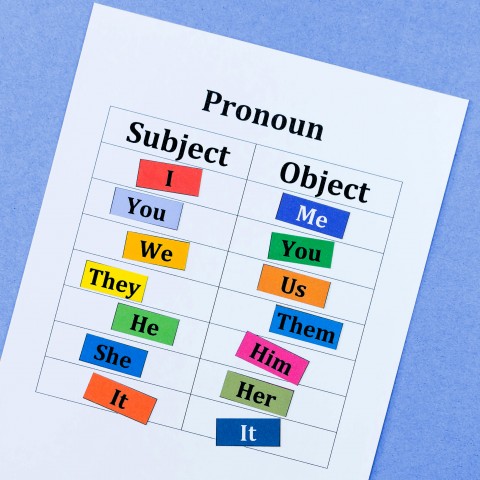
3. Word Structure and Agglutination
In Turkish grammar, suffixes and vowel harmony play a huge role in how words are formed and used. In this section, we’ll introduce you to word structure and agglutination in Turkish.
Structure of Words
In the structure of a Turkish word, a vowel always follows a consonant and a consonant always follows a vowel:
- ➢ bebek (“baby”)
➢ araba (“car”)
Therefore, if you see a word where one consonant follows another, you can tell that it’s a loanword:
- ➢ pratik (“practical”)
➢ armut (“pear”)
In order to keep the “vowel + consonant” rule, buffers are used. Those buffers are “y, n, s.”
You can see some relevant examples of this in our section on vowel harmony and buffers.

Agglutination of Words
Turkish is called an agglutinative language, meaning that new words are formed by adding suffixes to the root words. To give you an idea, a suffix can be added to a noun to 1) make it another noun, or 2) turn it into a verb. It can also be added to a verb to make it a noun or another verb.
Are you confused? Here are some examples to help you understand these Turkish suffix rules better:
- ➢ Yolcu (Noun) – “Passenger”
Yolcu+luk = Yolculuk (Noun) – “Trip”
- ➢ Göz (Noun) – “Eye”
Göz+le = Gözle (Verb) – “Observe,” “Monitor”
- ➢ Bil (Verb) – “Know”
Bil+mece = Bilmece (Noun) – “Puzzle”
- ➢ Kal (Verb) – “Stay”
Kal+dır = Kaldır (Verb) – “Lift,” “Remove”
4. Suffixes, Vowel Harmony, and Buffers
People who want to learn Turkish grammar and vocabulary usually think that these characteristics are really interesting, probably because they don’t exist in most other languages. I wonder if you’ll agree with them!
That said, these are some of the most important Turkish language grammar rules, so pay attention.
Vowel Harmony
In Turkish, words are structured so that vowels follow a certain pattern, and this pattern is called vowel harmony. It’s used to determine which vowel will be used when adding a suffix to a word. Here’s a table showing the vowel types:
| FRONT | BACK | |||
| UNROUNDED | ROUNDED | UNROUNDED | ROUNDED | |
| OPEN | -e | -ö | -a | -o |
| CLOSED | -i | -ü | -ı | -u |
And here are the vowel harmony rules:
- Back vowels follow back vowels and front vowels follow front vowels.
- Unrounded vowels follow unrounded vowels.
- A rounded vowel can be followed by a mix of rounded closed and unrounded open vowels.
Suffixes
Let’s see when suffixes are added:
- Suffixes are based on the person/subject that a verb alludes to.
- Suffixes are used when the subject is plural.
- Suffixes are used based on the tenses.
- Suffixes are used if there is negativity.
- Suffixes are used if interrogative particles will be used.
- Suffixes are used when passive, reflexive, causative, or a verb of mutual action will be formed.
- When definite nouns or pronouns are used as an object, then they take the “-ı, -i, -u, -ü” suffixes, based on the vowel harmony rules.
- Suffixes are used when using possessive pronouns, since there are no separate words for them in Turkish. The suffixes “-m, -ım, -im, -um, -üm” (in conjugated forms) come after the pronoun to make it possessive.
- Suffixes are used when motion towards an object (to), motion from an object (from), and static location (on, at) is to be specified.
It’s a great thing to be able to use the right suffix! However, you also need to make sure that you choose the right vowels for those suffixes based on the vowel harmony.
Buffers
As mentioned earlier, there are three buffers (y, n, s). These are used to maintain the “vowel + consonant” rule when adding suffixes.
- Usage of “y“:
- Used with an accusative suffix
Example: Silgi+y+i = Silgiyi (“The eraser”) - Used with dative. (Movement towards something)
Example: Parti+y+e = Partiye (“To the party”)
- Used with an accusative suffix
- Usage of “n“:
- Used with genitive case [Ownership]
Example: Ayna+n+ın = Aynanın (“The mirror’s”)
Aynası+n+ın = Aynasının (“His/her/its mirror”) - Used for nouns that already have suffixes
Example: Boya+lar+ı+n+a = Boyalarına (“To their paints”)
Oda+sı+n+dan = Odasından (“From his/her/its room”)
- Used with genitive case [Ownership]
- Usage of “s“:
- Only used with the third person suffixes (-ı, -i, -u, -ü)
Example: Elma+s+ı = Elması (“His/her/its apple”)
- Only used with the third person suffixes (-ı, -i, -u, -ü)
5. Possessives
In Turkish grammar, possessives are formed much differently from how English speakers are used to. In this section, we’ll cover two topics: how to form possessive pronouns and how to use the possessive (genitive) case.
Possessive Pronouns
In the Turkish language, there aren’t separate words that stand for possessive pronouns. However, suffixes (-m, -ım, -im, -um, -üm), in conjugated forms, come after a pronoun to make it possessive. Let’s take a look at a couple of examples:
- ➢ Sen+in = Senin (“Your”)
➢ Biz+im = Bizim (“Our”)
Possessive pronouns can be omitted because the nouns they are modifying also take suffixes, which imply the possessive pronoun. However, if you want to stress the possessive pronoun, then you can use it in the sentence. Here are some examples:
- ➢ Benim valizim çok küçük. (“My suitcase is very small.”)
Valizim çok küçük. (“My suitcase is very small.”)
- ➢ Sizin aileniz nerede? (“Where is your family?”)
Aileniz nerede? (“Where is your family?”)
Possessive (Genitive) Case
In the possessive case, both the “possessor” and “possessed” are suffixed. Here are a couple of examples:
- ➢ Araba+nın anahtar+ı (“The car’s key”)
➢ Elbise+nin düğme+si (“The button of the dress”)
6. Verbs and Conjugation
The final points we’ll cover today have to do with verbs and conjugation.
- → Because these are such crucial topics, we recommend that you also study our lesson on the Top 20 Turkish Verbs and read our blog post on Turkish verb conjugation.
How to Form Different Types of Verbs
- Passive verbs are formed by adding the affixes -n, -il, or -in. Here are some examples:
Okumak (“To read”)
Oku+n+mak (“To be read”)
Germek (“To stretch”)
Ger+il+mek (“To be stretched”)
Silmek (“To erase”)
Sil+in+mek (“To be erased”)
- Causative verbs are formed by adding the affixes -dir, -t, or -ir. Below are some examples:
Yemek (“To eat”)
Ye+dir+mek (“To make somebody eat”)
Pişirmek (“To cook”)
Pişir+t+mek (“To have something cooked”)
İçmek (“To drink”)
İç+ir+mek (“To make someone drink”)
- Reflexive verbs are formed by adding the -in affix. Here is an example:
Giymek (“To wear clothes”)
Giy+in+mek (“To dress oneself”)
- Verbs of mutual action are formed by adding the -iş affix. For example:
Çarpmak (“To hit”)
Çarp+ış+mak (“To collide”)
Reported Past Tense
I can hear you asking, “Reported tense? What is that?”
You’re absolutely right in asking this question because it’s not a very common tense.

It’s used:
- when the speaker is explaining something that he/she hasn’t witnessed, but heard from someone else
Annem bana hediye almış. (“My mother bought me a gift.”)
[My mother told me she did, but I didn’t see her buying it.]
- when telling a story
Güzel bir kız varmış. (“There was a beautiful girl.”)
[I haven’t seen the girl, it’s just a character in a story.]
- when the speaker is telling someone that he/she (the speaker) has done something without noticing it
Durakta uyumuşum ve otobüsü kaçırmışım. (“I slept at the bus stop and missed the bus.”)
[I didn’t realize I slept and missed the bus.]
Ben kitabı daha önce okumuşum. (“I have read this book before.”)
[I started reading a book, but realized that I read it before and forgot until now.]
- when you’re telling someone about your dream
Rüyamda çok zenginmişim. (“I was very rich in my dream.”)
[It’s like storytelling; you’re telling someone about your dream, which is not reality.]
- when imagining something and telling someone
Mesela, benim iki çocuğum varmış. (“For example, I had two kids.”)
[This is again not reality; you’re imagining that you had two kids.]
Verb Conjugation
In Turkish grammar, verb conjugation is based on the following factors:
- Person / Subject: In Turkish, different suffixes are added to a verb based on the person/subject it alludes to. Vowels in the suffixes change based on the vowel harmony rules.
- Number of Subjects: Whether the subject is singular or plural impacts the suffix that the verb will get.
- Politeness Level: As mentioned above, the plural “you” is also the polite “you” and the same rules are applied to both.
- Tense: Based on the tense, verbs take different suffixes.
7. Access More Turkish Grammar Content on TurkishClass101.com
In this article, we presented you with information on the major topics of Turkish grammar. Which aspects seem the most difficult to you, and why? Let us know in the comments!
Now that you have a better idea of what to expect from the language, you should have little trouble as you continue learning Turkish grammar online with us.
Want to learn Turkish grammar and vocabulary in depth? Bookmark TurkishClass101.com! Take advantage of our numerous audio recordings, vocabulary lists, and free resources—including our Turkish-English dictionary that you can refer to anytime.
Don’t forget that with a Premium PLUS subscription, you can also utilize our MyTeacher service to practice with a private teacher. He or she will work with you one-on-one and provide you with lessons and assignments tailored to your needs and goals, as well as personalized feedback to help you improve.
Best of all, you can learn Turkish anywhere, anytime by downloading the app for free!
Do you have suggestions, comments, or concerns? You can always provide us with feedback about all of the resources provided at TurkishClass101.com!

Well-Known Turkish Quotes That Learners Should Know

I don’t know how you feel, but quotes always make me excited, no matter their country of origin. They open my eyes and my heart. It’s intriguing to ponder what people lived and experienced, whether good or bad, that inspired their words of wisdom! Some of these quotes inspire us, some motivate us, some make us think, and some teach us something!
We believe that quotes can also give you greater insight into a country’s language and culture.
Are you ready to discover some great Turkish quotes with me? In this article, we’ll look at several Turkish quotes with translations in English, as well as some popular quotes from other languages translated into Turkish. This will give you the best of both worlds!
 Table of Contents
Table of Contents
- Quotes About Trust
- Quotes About Hope
- Quotes About Time
- Quotes About Knowledge and Ignorance
- Quotes About Money
- Quotes About Other Topics
- Rumi Quotes in Turkish
- Learn More With TurkishClass101
1. Quotes About Trust
What does trust mean to you? Here are some Turkish trust quotes to help you gain cultural insight into how the Turkish perceive it.
| 1 | Quote in Turkish | Kadınlar beğenince değil, güvenince âşık olur. |
| Literal Translation in English | “Women fall in love when they trust, not when they like.“ | |
| This is an anonymous quote which shows the importance of trust for women. | ||
| 2 | Quote in Turkish | Bir ölümün bir de kaybolan güvenin telafisi yok bu dünyada. |
| Literal Translation in English | “There is no compensation for either death or lost trust in this world.” | |
| This is another anonymous quote. It implies that losing trust in someone is as bad as death; just as trust cannot be recovered, neither can death be cured. | ||
| 3 | Quote in Turkish | İşin içine bir kere güvensizlik girdi mi, hiç bir şey eskisi gibi olmuyor. |
| Literal Translation in English | “When there is distrust, nothing is as it was in the past.” | |
| This is another anonymous quote. It means that distrust damages relationships. | ||
2. Quotes About Hope
Feeling discouraged or afraid of the future? Maybe one of these Turkish quotes about hope will motivate you to keep moving forward!

| 4 | Quote in Turkish | En geveze kuş ümittir. Kalbimizde hiç susmaz. |
| Literal Translation in English | “The most talkative bird is hope. It never stops in our hearts.” | |
| This is a quote by Cenap Şahabettin, who was a Turkish writer and poet. It means that our hearts are full of hope. | ||
| 5 | Quote in Turkish | Her kışın bir baharı, her gecenin bir sabahı vardır. |
| Literal Translation in English | “Every winter has its spring and every night has its morning.” | |
| This is a quote by Bediüzzaman Said Nursi, who was an Ottoman scholar and the founder of the Nurism movement. Corresponding quote in English: “Every cloud has a silver lining.” | ||
| 6 | Quote in Turkish | Tünelin ucunda ışık görünmese bile, ışık varmış gibi yürümek ve ışığın görüneceğine inanmak gerekir. |
| Literal Translation in English | “Even if there is no light at the end of the tunnel, it is necessary to walk as if there is light and believe that the light will appear.” | |
| This quote is by Amin Maalouf, who was a Lebanese-born French author. This quote encourages you to be hopeful even in hopeless situations. | ||
3. Quotes About Time
Time plays an important role in our lives. The following Turkish quotes on life focus on the concept of time and how it applies to us.
| 9 | Quote in Turkish | Bildiğim tek şey hiçbir şey bilmediğimdir. |
| Literal Translation in English | “All I know is that I know nothing.” | |
| This deep quote is from the Greek philosopher Socrates. It tells us that no matter how much we know, there is always much more to learn, and we should never stop searching and learning. | ||
| 10 | Quote in Turkish | Cahile söz anlatmak, köre renk tarifi gibidir. |
| Literal Translation in English | “To persuade an ignorant is like describing colors to a blind person.” | |
| This is a quote from İmam Evzai, who was a scholar and writer. The quote implies that it’s very difficult to deal with ignorant people. | ||
| 11 | Quote in Turkish | Dünyada her kötülük, daima cehaletten gelir. |
| Literal Translation in English | “Every evil in the world always comes from ignorance.” | |
| This quote is from Albert Camus, who was a French Algerian philosopher, author, and journalist. It emphasizes how bad and dangerous ignorance is. | ||
| 12 | Quote in Turkish | Eylem halindeki cehaletten, daha korkunç bir şey olamaz. |
| Literal Translation in English | “Nothing is scarier than ignorance in action.” | |
| This is a quote by Goethe, who was a German poet, novelist, playwright, critic, theatre director, scientist, and statesman. This quote also underlines the danger of ignorance. | ||
| 13 | Quote in Turkish | Cehalet, gönüllü talihsizliktir. |
| Literal Translation in English | “Ignorance is voluntary misfortune.” | |
| This is a quote from De Segur, who was a French general and historian. With this quote, he meant that people choose to be ignorant, and that it’s a bad choice because it leads to misfortune. | ||
5. Quotes About Money
Money is a crucial element of modern life, making it essential to manage it well. Here are a couple of quotes about money to shed some light on the topic.

| 14 | Quote in Turkish | Para iyi bir hizmetçi, kötü bir efendidir. |
| Literal Translation in English | “Money is a great servant, but a bad master.” | |
| This is a quote from Francis Bacon, who was an English philosopher and statesman. In saying it, he meant that those who know how to use and manage their money are those who make their money work for them. If people are not good masters of their money, then their money will start controlling them. | ||
| 15 | Quote in Turkish | İnsanın kazandığı paradan değil, paranın kazandığı insandan korkulur. |
| Literal Translation in English | “It’s not to be scared of the money that man earns, but the man who is earned by money.” | |
| This quote is from Necip Fazıl Kısakürek, who was a Turkish novelist, playwright, poet, and Islamist ideologue. If someone is making money by spending some effort, that’s good; but if he or she is being bought by money, then it’s dangerous. | ||
6. Quotes About Other Topics
Below are a few more Turkish quotes about life that didn’t quite fit into the other categories. Enjoy!
| 16 | Quote in Turkish | Biz ayrı dünyaların insanlarıyız. |
| Literal Translation in English | “We are from different worlds.” | |
| This quote has been used in many Turkish movies, usually between two lovers. It’s also used as a joke between friends in daily life. | ||
| 17 | Quote in Turkish | Açıklamalarla zamanınızı boşa harcamayın: insanlar sadece duymak istediklerini duyarlar. |
| Literal Translation in English | “Don’t waste your time with explanations: people only hear what they want to hear.” | |
| This is a quote from Paulo Coelho, a Brazilian lyricist and novelist. He wanted to point out that some people are prejudiced, egocentric, and not open to new ideas or thoughts; if they’re not willing to listen, no matter what, they won’t hear you. | ||
| 18 | Quote in Turkish | Sevelim, sevilelim, bu dünya kimseye kalmaz. |
| Literal Translation in English | “Let’s love, be loved, this world shall be left to no one.” | |
| This is by Yunus Emre, a poet and mystic who had a considerable impact on Turkish literature. He had great poems and quotes about love and human destiny. With this quote, he emphasized the fact that life is short and nobody is permanent in the world; he suggested not wasting the limited time we have and to love each other instead. | ||
| 19 | Quote in Turkish | Herkesin haksız olması, senin haklı olduğunu göstermez. |
| Literal Translation in English | “The fact that everyone is wrong does not show that you are right.” | |
| Some people say this quote belongs to Aristotle, and some say it belongs to Camus. Based on my internet research, it seems to be anonymous. This is a quote to awaken those who always consider themselves right. | ||
| 20 | Quote in Turkish | Herkes kalbinin ekmeğini yer. |
| Literal Translation in English | “Everyone eats the bread of his/her bread.” | |
| Corresponding quote in English: “One reaps what one sows.” This is a quote used by Seda Sayan, a Turkish singer and actress. | ||
| 21 | Quote in Turkish | İmkânın sınırını görmek için imkânsızı denemek lazım. |
| Literal Translation in English | “It’s necessary to try the impossible, to see the limitations of the possibility.” | |
| This quote is from Fatih Sultan Mehmet, who was one of the well-known sultans in the Ottoman Empire and the Conqueror of Istanbul. This is a very motivational quote about not giving up. | ||
7. Rumi Quotes in Turkish
Some of the most famous Turkish quotes are those from Rumi, a poet, theologian, scholar, and Sufi mystic. He influenced many cultures, and today he’s considered a symbol of peace and tolerance.
I personally think that each and every one of his quotes is very valuable, but I’ll only include a few for the sake of this article.
I’m curious to know if you’ve also found these Rumi quotes in Turkish inspiring and motivational. Let me know in the comments!
| 22 | Quote in Turkish | İyi dostu olanın aynaya gereksinimi yoktur. |
| Literal Translation in English | “The one who has a good friend does not need a mirror.” | |
| The meaning of this quote is a little deeper than it sounds. If your friend is good, you don’t need a mirror to see your imperfections. He or she will warn you about your imperfections and help you overcome them. | ||
| 23 | Quote in Turkish | Ya olduğun gibi görün, ya göründüğün gibi ol. |
| Literal Translation in English | “Either look as you are or be as you look.” | |
| This quote is about being yourself and being honest about who you are. | ||
| 24 | Quote in Turkish | Bilmez misin ki cevap vermemek de cevaptır. |
| Literal Translation in English | “Don’t you know that not answering is also the answer?” | |
| Sometimes silence means a lot. This quote suggests being wise with how you use your silence and your words. | ||
| 25 | Quote in Turkish | Ne kadar bilirsen bil, söylediklerin karşındakilerin anlayabileceği kadardır. |
| Literal Translation in English | “No matter how much you know, what you say is as much as anyone can understand.” | |
| When communicating with others, we should consider the knowledge and experience of the other person and try to be as clear as possible. Otherwise, the knowledge we have won’t be conveyed or get us to the point. | ||
| 26 | Quote in Turkish | Bazı insanlar bize armağandır, bazıları ise ders. |
| Literal Translation in English | “Some people are gifts to us, others are lessons.” | |
| Some people are like gifts; they make us happy and we treasure them. Others teach us lessons related to the bad experiences they bring to our lives. | ||
| 27 | Quote in Turkish | Gönülden dile yol olduğu gibi, dilden de gönüle yol vardır. |
| Literal Translation in English | “As there is a path from heart to the tongue, there is also a path from tongue to the heart.” | |
| Rumi used this phrase at the end of a conversation with his son. He said: “If you don’t want anybody to harm you, then don’t say bad things and don’t have bad thoughts about him/her.” In essence, it means: “Kindness opens all the doors.” | ||
8. Learn More With TurkishClass101
In this article, we presented you with several Turkish language quotes from Turkey and from around the world. From now on, you can impress your Turkish friends, colleagues, or even your boss, by using these quotes at just the right time.
Which one was your favorite, and why?
Do you want to go even deeper into the Turkish language and culture? Then create your free lifetime account on TurkishClass101.com! We offer numerous audio lessons, tons of vocabulary lists, and free resources such as our Turkish-English dictionary.
Don’t forget that by signing up for a Premium PLUS account, you can take advantage of our MyTeacher service and practice with your own private teacher.
Better yet, you can download the app for free and use it wherever you are.
Last but not least, please continue to provide us with feedback about all of the resources provided at TurkishClass101.com!
Happy learning, and stay safe out there.

Your Guide to the Business Language of Turkey

Will you be having a job interview with a Turkish company? Are you getting ready to work in Turkey or travel there for a business trip? If you answered “yes” to one of these questions, then here comes the next question: Do you think you’re ready for the challenge?
If not, don’t panic. Today, we’ll cover some basic business terms in Turkish and common Turkish business phrases. By the end of this article, you’ll be able to greet your colleagues or your future boss, introduce yourself, make travel arrangements, participate in meetings, and take care of correspondence in Turkish.
Let’s get started and make your transition to the Turkish business environment that much smoother!
 Table of Contents
Table of Contents
- Turkish Terms Used in Business
- Greetings and Introductions in Business
- Interacting with Coworkers
- Participating in a Meeting
- Taking Care of Business Communications
- Going on a Business Trip
- Learn More Words, Terms, and Phrases with TurkishClass101
1. Turkish Terms Used in Business
First, let’s cover the very basics:
- İş (“Business”)
- İş adamı (“Businessman”)
- İş kadını (“Businesswoman”)
From this point on, we’ll classify the basic business terms in Turkish based on category so that you can remember them easily.
Company-related words
Here are some useful terms you can use when talking about a company:
| Turkish | English |
| Şirket | Company |
| Kuruluş | Enterprise |
| Kurum | Corporation |
| Firma | Firm |
| Hissedar | Shareholder |
| Küçük ve orta ölçekli işletme | Small- or medium-sized business |
| Kâr amacı gütmeyen kuruluş | Non-profit organization |
| Anonim şirket | Joint-stock company |
| Çok uluslu şirket | Multi-national company |
| Uluslararası şirket | International company |
| Kurumsal firma | Corporate firm |
| Perakende | Retail |
| Toptan | Wholesale |
| Ana merkez | Headquarter |
| Şube | Branch |
| Yan kuruluş | Subsidiary |
| Bayi | Dealer |
| Ofis | Office |
| Büro | Office / Bureau |
| Departman | Department |
You may also find our vocabulary list of Words and Phrases for HR and the Recruitment Process useful!
Work-related terms
Here are some useful words for talking about jobs and work:
| Turkish | English |
| Çalışmak | To work |
| İş | Business / Work / Job |
| Pozisyon | Position |
| İşveren | Employer |
| Personel | Personnel |
| Çalışan | Employee |
| İşçi | Worker |
| Patron | Boss |
| İş arkadaşı | Colleague |
| Kariyer | Career |
| Yönetim | Management |
| Üst | Superior |
| Müdür | Manager |
| Direktör | Director |
| Alt kademe | Subordinate |
| Staj | Internship / Apprenticeship |
| Stajyer | Intern / Apprentice |
| Sözleşme | Agreement |
| Kontrat | Contract |
| Vardiya | Shift |
| Fazla mesai | Overtime |
Make sure to check out our Workplace vocabulary list to learn even more words along with their pronunciation.
Words about money
Money is a very important instrument in nearly every aspect of life, especially in business. Let’s take a look at money-related terms in Turkish:
| Turkish | English |
| Para | Money |
| Maaş | Salary |
| Ücret | Wage |
| En düşük ücret (Asgari ücret) | Minimum wage |
| Gelir | Income / Revenue |
| Net gelir | Net income / Net revenue |
| Brüt gelir | Gross income / Gross revenue |
| İkramiye | Bonus |
| Kâr | Profit |
| Bordro | Payroll |
| Hisse | Share |
| Vergi | Tax |
| Ön ödeme | Advance payment |
| Banka | Bank |
| Banka hesabı | Bank account |
Want to learn more? Head over to our list of Money-Related Expressions for Everyday Life!
2. Greetings and Introductions in Business
Greetings and introductions are very important in both business and social life. When doing business with Turkish companies, first impressions matter, so you need to have a good and impressive start!
Greetings
When greeting someone, you can use any of the following words, regardless of how formal the situation is.
- Merhaba. (“Hello.”)
- Günaydın. (“Good morning.”)
- İyi günler. (“Good day.”) *
- İyi akşamlar. (“Good evening.”) *
(*): You can also use these to say goodbye in both formal and informal situations.
If the situation is very informal, you can say:
- Selam. (“Hi.”)

To say goodbye in a formal manner, you can use one of these phrases:
- Hoşçakalın. (“Goodbye.”) [Literally: “Stay pleasantly.”]
- Görüşmek üzere. (“See you.”) [Literally: “Hope to see you.”]
To say goodbye to a coworker you’re close with, you can use any of the following words:
- Bay bay. / Bay. (“Bye bye.” / “Bye.”)
- Hoşçakal. (“Goodbye.”) [Literally: “Stay pleasantly.”]
- Görüşürüz. (“See you.”)
You can see our vocabulary lists on Common Ways to Say Hello and the Most Common Ways to Say Goodbye for more info!
Self-introductions
Giving a proper self-introduction is just as important as greeting. Here are some useful phrases you can use to introduce yourself when socializing, networking, or engaging in other business situations.
- Ben Mary. (“I’m Mary.”)
- Benim adım Mary. (“My name is Mary.”)
- Benim ismim Mary. (“My name is Mary.”)
- Otuz yaşındayım. (“I’m thirty years old.”)
- Amerikalıyım ama artık Türkiye’de yaşıyorum. (“I’m American, but I live in Turkey now.”)
- Yale Üniversitesi’nden mezun oldum. (“I have graduated from Yale University.”)
- Ben yeni Satın Alma Müdürüyüm. (“I’m the new Purchasing Manager.”)
Don’t forget to read our article Turkish Greetings: How to Introduce Yourself in Turkish for more-detailed information and more useful phrases.
Job interviews
The job interview is a significant aspect of business life and might even have an impact on your future. It’s relatively easy to fill in a job application, pass a test, and even carry out a conversation over the phone, but what will happen when you’re having a face-to-face job interview in Turkish?
Don’t worry! Below are some examples of questions that may be asked during the interview and some useful business phrases in Turkish one could use to answer them.
1. Bana eğitiminizden bahseder misiniz? (“Can you tell me about your education?”)
- Harvard üniversitesinden mezun oldum. (“I graduated from Harvard University.”)
- Finans okudum. (“I studied finance.”)
- Harvard Üniversitesi’nde işletme yüksek lisansı yaptım. (“I have an MBA degree from Harvard University.”)
2. Daha önce nerelerde çalıştınız? (“Where have you worked before?”)
- 4 yıl Unilever’de muhasebe departmanında çalıştım. (“I have worked at Unilever for four years in the accounting department.”)
- Şu an P&G’de finans müdürü olarak çalışıyorum. (“Currently, I’m working as a financial manager at P&G.”)
3. Kaç dil biliyorsunuz? Bunlar neler? (“How many languages do you speak? What are they?”)
- Ana dilim İngilizce. (“My mother tongue is English.”)
- Almanca biliyorum. (“I know German.”)
- Ve biraz da Türkçe. (“And also a little bit of Turkish.”)
Don’t get discouraged if you don’t understand something. Feel free to ask them to repeat what they said.
- Sorunuzu tekrar edebilir misiniz lütfen? (“Could you please repeat your question?”)
- Pardon anlayamadım. (“Pardon me, I couldn’t understand.”)
3. Interacting with Coworkers
Did you ace your job interview? Congratulations! Now it’s time to meet your new coworkers. Here are some practical Turkish business phrases you can use to communicate with your new work team.
Asking for help
Here are some business Turkish phrases that you can use to get help. Note that when the letters in parentheses are added, the questions become formal.
- Bana yardım edebilir misin(iz) lütfen? / Bana yardımcı olabilir misin(iz) lütfen? (“Can you help me, please?”)
- Bunu bana anlatabilir misin(iz) lütfen? (“Can you explain this to me, please?”)
- Bu sistemi nasıl kullanacağımı gösterebilir misin(iz)? (“Can you show me how to use this system, please?”)
- Bahsettiğin(iz) dokümana nasıl ulaşabilirim? (“How can I access the document you mentioned?”)
- Bilgisayarın şifresini verebilir misin(iz)? (“Can you give the password of the computer?”)
Showing appreciation
No matter where you are in the organizational hierarchy, showing appreciation toward your colleagues and subordinates is an important element of motivation.
- Tebrikler! / Tebrik ederim! (“Congratulations!”)
- Katkılarınız için teşekkürler. (“Thanks for your contribution.”)
- Bu büyük bir başarı. (“This is a great success.”)
- Başarılarınızın devamını dilerim. (“I wish you continued success.”)
- İyi iş çıkardınız! (“Good job!”)
Expressing concerns
Of course, things in the garden aren’t always rosy! There will be times when you’ll have concerns you want to express. Here are some Turkish phrases for business to give you a voice in the matter:
- Ben bunu anlamadım. (“I didn’t understand this.”)
- Bana bu konuda bir bilgi verilmedi. (“I wasn’t informed about this.”)
- Bana bu konuda bir eğitim verilmedi. (“I wasn’t trained on this topic.”)
- Bunun için bütçemiz yok. (“We don’t have a budget for this.”)
- Bu kadar zamanda bu işi yetiştiremeyiz. (“We can’t get this job done within this time frame.”)
- Bu dokümanda bir hata var. (“There is an error in this document.”)
- Bununla ilgili bir veri yok. (“There is no data related to this.”)
- Bu toplantıyı ertelemeliyiz/öne çekmeliyiz. (“We must postpone/bring forward this meeting.”)

There are also a couple of idioms that you can use. Be careful not to sound like you’re complaining, though!
- İşim başımdan aşkın. (“I’m overly busy.”)
- Başımı kaşıyacak vaktim yok. (“I don’t have time to catch my breath.”)
You can find more Essential Idioms to Make You Sound Like a Native Speaker on our website!
Making apologies
Everyone makes mistakes, and the best way to stay on good terms with your colleagues or boss is to offer the proper apology. Here are some phrases you can use to do so:
- Özür dilerim, fevri davrandım. (“I apologize, I acted impulsively.”)
- Üzgünüm. (“I’m sorry.”)
- Yardımcı olamadığım için üzgünüm. (“I’m sorry, I couldn’t help.”)
- Bugün olanlar için üzgünüm. (“I’m sorry for what happened today.”)
If you want to learn more apology phrases, read our blog post on How to Say Sorry in Turkish.
Making plans for after-work social activities
If you want to ask your colleagues to go out after work, you can use any of the phrases below. Note that when the letters in parentheses are added, the questions become formal.
- İş çıkışı bir bira içmeye gidelim mi? (“Shall we go for a beer after work?”)
- Mesai sonrası bize katılmak ister misin(iz)? (“Would you like to join us after work?”)
Here are some questions you can ask to get to know your colleagues better during after-work activities:
- Hangi departmanda çalışıyorsun(uz)? (“Which department are you working in?”)
- Hangi proje üzerinde çalışıyorsun(uz)? (“Which project are you working on?”)
- Kaç yıldır burada çalışıyorsun(uz)? (“How many years have you been working here?”)
Make sure you check out our list of the Top 15 Questions You Should Know for Conversations to get more ideas!
4. Participating in a Meeting
Meetings are an indispensable aspect of business life. Let’s review some practical Turkish phrases for business meetings!
- Toplantı (“Meeting”)
- Toplantı ne zaman? (“When is the meeting?”)
- Toplantı nerede? (“Where is the meeting?”)
- Toplantı hangi odada? (“In which room is the meeting?”)
- Toplantı ne kadar sürer? (“How long will the meeting take?”)
- Herkes buradaysa, toplantıya başlayalım. (“If everyone is here, let’s start the meeting.”)
- Başka fikri olan var mı? (“Does anybody have any other ideas?”)
- Size katılıyorum. (“I agree with you.”)
- Ne yazık ki size katılmıyorum. (“Unfortunately, I don’t agree with you.”)
- Herhangi bir önerisi olan var mı? (“Does anybody have any suggestions?”)
- Sanırım bir sonraki konuya geçebiliriz. (“I think we can move on to the next topic.”)
- Çok verimli bir toplantı oldu. (“It was a very productive meeting.”)

5. Taking Care of Business Communications
Communication is an essential element of business. In this section, we’ll look at phrases you can use in Turkish business emails and over the phone.
Emails or letters
Nowadays, electronic correspondence is often used in place of traditional business letters. However, there are still situations where letters are sent out to public authorities or other businesses.
Anyhow, whether you’re writing a Turkish business letter or an email, there will be a:
Salutation Sentence
- Sayın Yetkili (“To whom it may concern”)
- Sayın Pam Carlton (“Dear Pam Carlton”)
- P&G Satın Alma Müdürlüğü’ne (“To the Purchasing Manager of P&G”)
- Merhaba Mehmet Bey (“Hello, Mr. Mehmet”) *
- Bay Johnson merhaba (“Hello, Mr. Johnson”) **
(*) This is mostly used in email. Note that Mehmet is the person’s first name.
(**) This is mostly used in email. This time, the person’s last name is used.
Body and Conclusion of the Email
- Parting words
- Name, last name, and signature
- ❖ Saygılarımla (“Sincerely yours”)
❖ Sevgiler (“Sincere/warm regards”)
❖ Selamlar (“Greetings” / “We salute you”) **
(*) This is informal.
(**) This is neither formal nor informal. It’s somewhere in-between.
Business calls
While audio conference tools are very popular these days, phone calls are still an active part of worklife in Turkey.
Alo (“Hello”) is the most popular way to answer the phone in Turkish. You can use it when talking to your colleagues, but a receptionist wouldn’t normally answer the phone that way. In Turkey, business receptionists would probably start by saying the company name, and then ask:
- Size nasıl yardımcı olabilirim? (“How may I help you?”)
Here’s a possible answer:
- Mehmet bey ile görüşmek istiyorum. (“I want to talk to Mr. Mehmet.”)
Or:
- Beni muhasebe departmanına bağlayabilir misiniz? (“Can you connect me to the accounting department?”)

Here are a few more Turkish business phrases a receptionist might use:
- Hatta kalın lütfen. (“Please stay on the line.”)
- Sizi bir dakika bekleteceğim. (“I will have you wait for a minute.”)
- Mehmet Bey’in hattı meşgul. (“Mr. Mehmet’s line is busy.”)
- Mehmet Bey şu anda toplantıda. (“Mr. Mehmet is in a meeting now.”)
- Herhangi bir mesajınız var mı? (“Do you have any messages?”)
- Daha sonra tekrar arayabilir misiniz? (“Can you call again later?”)
- Notunuzu ileteceğim. (“I will forward your note.”)
Want to be prepared for your next Turkish phone call? Check out our list of Useful Phrases for a Phone Call to learn more phrases and hear their pronunciation.
6. Going on a Business Trip
Here are a few phrases you can use when buying a ticket or checking in at a hotel:
- Merhaba. 23 Nisan için İstanbul’a bir uçak bileti istiyorum. (“Hello. I want a flight ticket to Istanbul for April 23.”)
- Cam kenarında bir koltuk istiyorum. (“I want a seat by the window.”)
- Tek kişilik bir oda istiyorum. (“I want a single room.”)
- Akşam yemeği saat kaçta? (“What time is dinner?”)

Prepare for your travels well in advance with our list of the Top 30 Travel Phrases You Should Know!
7. Learn More Words, Terms, and Phrases with TurkishClass101
By now, you’ve learned many Turkish business phrases that you can start practicing today. Do you think you’re ready to participate in a meeting or go through your job interview in Turkish?
If you think you need more practice with Turkish phrases for business, visit TurkishClass101.com! We provide numerous audio recordings, tons of vocabulary lists, and free resources (including our Turkish-English dictionary), all of which you can refer to for detailed information about the Turkish language and culture.
Note that we also provide the Premium PLUS service MyTeacher, which allows you to practice with a private tutor. If you’re busy or prefer learning on your own time, you can download the app for free and use it wherever you are.
Happy Turkish learning, and good luck with your business endeavors!

Want to Learn Turkish Online? YouTube is the Key.

Learning a new language is a challenge, and let’s face it—it can be pretty boring at times.
Sitting at a table, buried in textbooks, trying to understand the finer points of grammar… This way of learning can be very difficult, especially for those who are auditory or visual learners. But did you know that you can balance out your learning experience and make it more fun? Just watch some videos!
If you’re bored with the traditional way of learning Turkish, YouTube can make all the difference! Turkish YouTube videos will expose you to the language and culture, and help you learn grammar and vocabulary in a way that’s more fun and natural. In addition, watching videos is a great way to improve your listening comprehension skills.
Interested? In this article, we’ll present our picks for the top ten Turkish YouTube channels for learners. We’ve made sure to include channels in a variety of categories and levels, so you’re sure to find something that interests you!
 Table of Contents
Table of Contents
- Learn Turkish with Mehtap
- Yasin Durak
- Türkçe
- Ruhi Çenet
- Evrim Ağacı
- Netd Müzik
- Cem Yılmaz
- Mösyö Taha
- Nefis Yemek Tarifleri
- Learn Turkish with TurkishClass101.com on YouTube
- TurkishClass101 – A Single Resource for All!
1. Learn Turkish with Mehtap
Category: Language
Level: All levels
On this Turkish YouTube channel, Mehtap offers friendly and fun videos where she teaches viewers about the language and culture. But that’s not all! She also has a few videos about Turkish cuisine, so don’t miss out on the chance to get some recipes for delicious Turkish food.
To give you an idea of what to expect, here’s a video from her channel:
While you learn Turkish online, YouTube channels like this one will help you reach fluency before you know it! Mehtap caters to all learner levels, so regardless of where you are on your language learning journey, she has some great content for you.
2. Yasin Durak
Category: Language
Level: Beginner & Intermediate
Yasin Durak teaches Turkish with simple examples, and he provides some of the best lessons about Turkish grammar on YouTube. What I like about his videos is that, when introducing new words, he repeats their pronunciation once or twice to make sure it’s clear. His videos are good for beginners and intermediate level learners.
You can watch the following video to get a better idea about Yasin Durak’s videos:
3. Türkçe
Category: Language
Level: Beginner
This channel is a little different from the others. While it provides the same type of Turkish lessons, the ones on this channel are offered in two different languages: Russian and English. This means that Russian speakers who don’t speak English can learn Turkish more easily.
Below is an A1 level video from the channel:
4. Ruhi Çenet
Category: Informative
Level: Advanced
Ruhi describes his channel as “The adventure of reading yourself, the world and the universe …”
He talks about a lot of different and interesting topics, usually offering a number of facts on a given topic. For example, he has videos about animal-built structures, an artificial sun, and facts about English people. This Turkish language YouTube channel covers so many different things that you’ll never get bored!
Below is a sample video you can watch:
This channel will not only teach you new words, but also demonstrate how they’re used in context—perfect for the advanced learner!
5. Evrim Ağacı
Category: Scientific
Level: Advanced
This is one of the largest, most visited, and most popular science channels in Turkey. There are a lot of videos, covering a range of topics. To give you an idea, here are some video titles that might draw your attention:
- Ay Tutulmasına Dair Bilmeniz Gereken Her Şey! – “Everything You Need To Know About Lunar Eclipse!”
- Hemofobi: İnsanları Neden Kan Tutar? Bazıları Kan Görünce Neden Bayılır? – “Hemophobia: Why Does Blood Affect People? Why Do Some People Pass out When Seeing Blood?”
- Bakteri ve Virüs: Sizi Hasta Eden Hangisi? Aralarındaki Farklar Neler? – “Bacteria and Virus: Which One Makes You Sick? What are the Differences between Them?”
- Houston Doğa Tarihi ve Bilim Müzesi’ne Bir Yolculuk! – “A Journey to the Houston Museum of Natural History and Science!”
- NASA’nın Uzaylıların Görmesini İstediği 115 Fotoğraf! – “115 Photos NASA Wants Aliens to See!”
Here’s a sample video that you can refer to:
By keeping up with this channel, you’ll not only improve your Turkish, but also gain some general knowledge.
6. Netd Müzik
Category: Music
Level: Intermediate & Advanced
Ready to learn Turkish and jam out to popular Turkish songs? YouTube channel Netd Müzik is the official broadcasting platform of music video clips in a variety of genres, from Turkish pop music to alternative music. These videos are provided from contracted music production companies.
This channel is very popular, with about 17 million followers. It’s not hard to see why: You can find music videos from both new singers and old favorites (like superstars Ajda Pekkan and Tarkan).
Here’s a video clip of Tarkan to cheer you up and give you an idea of the platform’s offerings:
Who knows? After a while, you may be able to sing a couple of lines from a Turkish song for your friends!
7. Cem Yılmaz
Category: Comedy
Level: Advanced
Cem Yılmaz is one of the most popular comedians in Turkey. This is his official YouTube channel, where he shares up-to-date posts about his ideas and art. There are also videos of his stand-up shows.
Advanced learners can gain insight into what makes Turkish people laugh, learn more vocabulary, and improve their listening skills. And best of all, your Turkish jokes may just bring down the house one day; I wouldn’t be surprised!
Below is a sample video of Cem Yılmaz. You can see for yourself that watching his videos is a fun way to improve your Turkish:
8. Mösyö Taha
Category: Entertainment
Level: Intermediate & Advanced
If you’re a Potterhead (for those who don’t know: a true Harry Potter fan), Mösyö Taha has your name written all over it. He has a good-sized Harry Potter collection, which he shares in his videos. On his channel, you can also expect:
- Concert clips featuring Harry Potter music
- Contests related to Harry Potter
- Videos about the films’ locations
- Other interesting Harry Potter-related videos
Here’s a sample video that you might find interesting:
9. Nefis Yemek Tarifleri
Category: Food
Level: Intermediate & Advanced
This Turkish cooking YouTube channel is also very popular, with followers from all over the world. Each video shares practical, easy, and delicious recipes from Turkey (and the world).
You can gain a lot of insight into Turkish culture through these videos, as well. Turkish cuisine is largely influenced by the Ottoman Empire, and every region in Turkey has different culinary traditions.
Let’s have a look at one of the videos, and see which recipe they shared with us:
If your meal planning has been getting dull, you now know where to find tons of yummy recipes while improving your Turkish. You can even impress your friends by inviting them over for a Turkish meal!
10. Learn Turkish with TurkishClass101.com on YouTube
Category: Language
Level: All levels
The TurkishClass101 YouTube channel is the best, quickest, simplest, and most fun way to learn Turkish. We offer quite a number of videos designed to help you benefit from all the methods of learning Turkish.
We teach you grammar, vocabulary, and pronunciation, and help you build your listening comprehension, writing, and speaking skills. We even introduce you to Turkish culture and traditions!
Here’s a sample video that will give you an idea of what you’ll find on our channel:
Make sure to bookmark our channel for later! You’ll be amazed with all the progress you make.
11. TurkishClass101 – A Single Resource for All!
In this article, I presented you with the best YouTube channels for learning Turkish and having fun at the same time. I hope you enjoyed sampling the different channel flavors, from comedy to scientific information.
When you set out to learn Turkish, YouTube is undoubtedly a very useful and effective tool. What’s more? It reinforces your learning and enhances your Turkish skills in a number of areas.
However, don’t forget that TurkishClass101.com is a single resource that has all the tools you need to learn Turkish. We provide numerous audio recordings, tons of vocabulary lists, and free resources (such as our Turkish-English dictionary), to help you get a better grasp of Turkish. And in the event that you have questions or concerns, you can always contact us and we’ll get back to you as soon as possible.
Note that we also have a MyTeacher service for Premium PLUS members, which allows you to practice with a private teacher.
Finally, you can download the app for free and use it wherever you are.
Which of these YouTube channels are you most excited to check out, and why? Are there any good ones we missed? Let us know in the comments!

How to Say Goodbye in Turkish

Do you think first impressions matter? I think they definitely do! Never underestimate the power of a friendly hello and a sincere goodbye!
In one of our previous articles, we covered different ways of saying hello in Turkish. Now, let’s move forward and discuss how to give the perfect Turkish goodbye in any situation. Like in any other language, there are numerous ways to say goodbye in Turkish, and the one you use depends on the context.
In this article, we’ll teach you many different ways to say goodbye in Turkish so you can leave a good impression. We’ll start with the most common ones! Start with a bonus, and download the Must-Know Beginner Vocabulary PDF for FREE!(Logged-In Member Only)
 Table of Contents
Table of Contents
- The Most Common Ways of Saying Goodbye in Turkish
- More Specific Ways to Say Goodbye
- Gestures Used to Say Goodbye in Turkey
- Practice Your Turkish Language Goodbyes with TurkishClass101!
1. The Most Common Ways of Saying Goodbye in Turkish

In Turkish, there are both formal and informal ways of saying goodbye. In the following sections, we’ll show you the most common ones in each category so you can be sure you’re using the best Turkish word for goodbye in any situation!
A- Informal
You can use the following Turkish goodbye phrases with friends, family, and other people you’re close to.
| Turkish | English | Tips |
| Baybay. | “Bye-bye.” | This is the easiest one, and it can save you in a pinch if you forget the other ones. |
| Bay. | “Bye.” | This is usually used among teenagers. |
| Hoşçakal. | “Goodbye.” | Literally, it means “Stay pleasantly.” |
| Görüşürüz. | “See you.” | Literally, it means “We see each other.” |
| Sonra görüşürüz. | “See you later.” | Literally, it means “We see each other later.” |
| Kendine iyi bak. | “Take care.” | The exact meaning is “Take care of yourself.” |
B- Formal
You can use these expressions when saying goodbye to older people or people you don’t know very well.
| Turkish | English | Tips |
| Hoşçakalın. | “Goodbye.” | Literally, it means “Stay pleasantly.” |
| Görüşmek üzere. | “See you.” | Literally, it means “Hope to see you.” |
| Tekrar görüşmek üzere. | “See you again.” | Literally, it means “Hope to see you again.” |
| Kendinize iyi bakın. | “Take care.” | Literally, it means “Take care of yourself.” |
2. More Specific Ways to Say Goodbye
Now, let’s look at how to say goodbye in Turkish when a generic phrase just won’t do.
A- Bye until ___. / See you ___.
Here are some useful phrases to use when you know you’ll be seeing the person again:
| Turkish (Informal) | Turkish (Formal) | English |
| Şimdilik hoşçakal. | Şimdilik hoşçakalın. | “Bye for now.” |
| Perşembe görüşürüz. | Perşembe görüşmek üzere. | “See you on Thursday.” |
| Haftaya görüşmek üzere. | Haftaya görüşmek üzere. | “See you next week.” |
| Salıya dek hoşçakal. | Salıya dek hoşçakalın. | “Bye until Tuesday.” |
| Cumaya kadar hoşçakal. | Cumaya kadar hoşçakalın. | “Bye until Friday.” |
B- When someone is traveling

When you’re seeing someone off, it’s always nice to wish them well during their travels.
| Turkish (Informal) | Turkish (Formal) | English |
| İyi yolculuklar. | İyi yolculuklar. | “Have a good trip.” |
| Güle güle git, güle güle gel. | Güle güle gidin, güle güle gelin. | The literal translation is “Go by laughing, come by laughing.” |
| Yolun açık olsun. | Yolunuz açık olsun. | “May your way be open.” |
| Allah’a emanet ol. | Allah’a emanet olun. | “May Allah be with you.” |
C- Saying goodbye on the phone
When you’re ending a phone call, you can use any of these phrases to say goodbye, regardless of how formal or informal the situation is:
- İyi günler. (“Have a good day.” / Literally: “Good days”)
- İyi akşamlar. (“Have a good evening.” / Literally: “Good evenings”)
- İyi geceler. (“Goodnight.” / Literally: “Good nights”)
Keep in mind that these phrases aren’t limited to phone calls; you can also use them when saying goodbye in other situations.
And here are two phrases you can only use in informal situations:
- Öptüm. (“I kissed you.”)
- Öpüyorum. (“I kiss you.”)
D- Saying goodbye forever
If you’re saying goodbye to someone you may never see again, there are a few ways you can wish them well for the last time:
- Elveda. (“Farewell.”)
- Yolun açık olsun. (“May your way be open.”)
- Allah’a emanet ol. (“May Allah be with you.”)
E- When you have to leave
If you have to head off somewhere, but someone else is staying behind, you can use this phrase:
- Allahaısmarladık. (“Bye-bye.” / Literally: “Entrust you to God.”)
If you’ve been invited to someone’s home and it’s time to leave, you can say goodbye with one of these phrases:
- Bize de bekleriz. (“Visit us, too.” / Literally: “We wait for you to our place as well.”)
- Bize de buyrun. (“Visit us, too.” / Literally: “We wait for you to our place as well.”)
F- When someone else is leaving
If you’re seeing someone off, you can say:
- Güle güle. (“Goodbye.”)
If someone has visited you at your house, and they need to leave now, you can say:
- Yine bekleriz. (“Come again.” / Literally: “We wait for you again.”)
G- Other situations
When someone is going on vacation or leaving for a holiday, you can say:
- İyi tatiller. (“Have a good vacation.”)
When someone is going to a social event such as a party, a concert, or a movie, you can say:
- İyi eğlenceler. (“Have fun.”)
When you, or the person you’re talking to, is going to bed, you can say:
- İyi geceler. (“Goodnight.” / Literally: “good nights”)
- İyi uykular. (“Sleep well.” / Literally: “good sleeps”)
- Allah rahatlık versin. (“Goodnight.” / Literally: “May Allah give you comfort.”)

When saying goodbye in the Turkish language, don’t forget to throw in some slang if you’re with friends!
- Kaçmam lazım. (“I have to run.” / Literally: “I have to escape.”)
- Ben çıktım. (“I’m leaving.” / Literally: “I’m out.”)
- Ben gittim. (“I’m gone.” / Literally: “I went.”)
We covered a lot of words and phrases! To hear and practice their pronunciation, please refer to the audio recordings in our “Goodbye in Turkish” vocabulary list.
3. Gestures Used to Say Goodbye in Turkey
In most cultures, people have certain gestures they use when saying goodbye, and Turkey is no different!
There are many gestures that you’re likely familiar with already:
- Waving to a friend or family member
- Blowing a kiss to someone you’re close to
- Giving someone you’re close to a kiss on the cheek or a hug
- Shaking hands with people you don’t know well

But there are quite a few gestures that are unique to Turkey!
For example, in Turkish culture, it’s completely normal for men to kiss each other on the cheeks when greeting or saying goodbye. To better illustrate why this is so important, let me share one of my memories with you:
I was living in the U.S., and my parents came to visit me. I had a Turkish friend whose husband was American, and my parents and I got together with them many times. After a while, my dad kissed this gentleman on the cheeks when seeing them off, thinking that they were becoming friends. Guess what? The next day, my friend’s husband kindly asked me to tell my dad not to kiss him again. Although he was familiar with Turkish culture, this parting gesture was very bothersome for him. Of course, we respected his opinion and my dad shook hands with him from then on. If you experience something similar while in Turkey, don’t be surprised!
Another gesture that’s common in Turkey, but not in the U.S., is to kiss someone’s hand and then put that person’s hand on your own forehead. This is done as a symbol of respect when you’re saying hello or goodbye to older people. Some people might prefer not to kiss the hand, and will instead put the hand on their chin and then on their forehead.
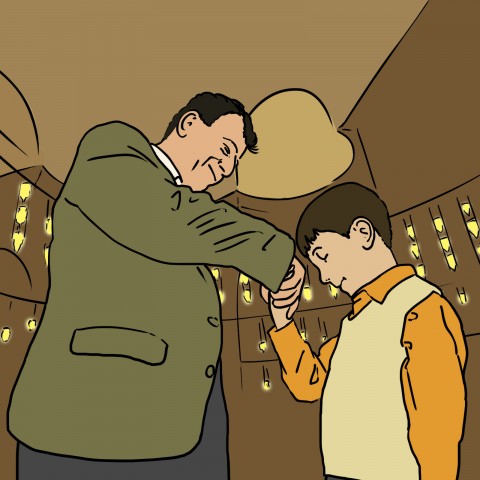
4. Practice Your Turkish Language Goodbyes with TurkishClass101!
After reading all of this information on how to say goodbye in Turkish, will you be able to say “goodbye” to me once you reach the end of this article? (I’m sure you can do it!)
If you think you still need to practice your goodbyes, though, you can explore TurkishClass101.com for relevant lessons and materials. And don’t forget our premium MyTeacher program, which allows you to practice one-on-one with a private teacher.
Is that all? Of course not! TurkishClass101 also has tons of vocabulary lists and other free resources (like this Turkish-English dictionary) to help you get a better grasp of Turkish.
And better still, you can download the app for free and use it wherever you are.
Last but not least, please continue to provide us with feedback about all of the resources provided at TurkishClass101.com!
Hoşçakalın, görüşmek üzere…

Is Turkish Hard to Learn?

Any time we set out to learn something new—whether it be cooking, sewing, ballet, or biology—it intimidates us. Not knowing what we’ll face makes us worry. Furthermore, we question our ability to learn that specific thing because we’ve never done it before. These same concerns pop up when someone starts learning another language.
But is Turkish hard to learn? Or is it easier than you think?
The answer is simple: It might be different from the languages you know and speak, but it’s not difficult.

Yes, it will take some time and effort to learn Turkish, but as we all know, nobody becomes an expert right away.
In this article, we’ll show you the easy parts of Turkish and help you understand the more challenging parts. This way, you’ll know what areas to really focus on when studying. TurkishClass101 will help you eliminate any prejudice you may have about the Turkish language and answer the question “How easy is Turkish to learn?”
Now, let’s start by talking about the easy features of Turkish.
 Table of Contents
Table of Contents
- What Makes Turkish Easy to Learn?
- So What Makes Turkish Hard to Learn?
- How to Start Learning Turkish
- TurkishClass101 is Awesome for Learning Turkish!
- Utilize TurkishClass101 to Learn Turkish Today!
1. What Makes Turkish Easy to Learn?
Turkish uses the Latin alphabet, which gives most learners an advantage because more than 6000 languages worldwide use the Latin-based alphabet. There might be additional letters (or even missing letters) compared to other Latin-based languages, but still, it’s not like you’ll need to rediscover America! You’ll just need to learn how the letters sound.
Great news for those who aren’t familiar with genders or gender-related conjugations: Turkish doesn’t have any grammatical gender. That’s one less thing to worry about!
Can you guess what else you won’t have to worry about? The article “the” doesn’t exist in Turkish. This means you don’t have to do anything special for nouns that function as subjects in a sentence. However, if a sentence has a noun that functions as an object, it will require a suffix:
- “The notebook is in my bag.” (Defter çantamın içinde.)
“Notebook” is used without an article in Turkish.
- “I put the notebook in my bag.” (Defteri çantamın içine koydum.)
Here, “notebook” takes the suffix “i” in Turkish to indicate the article “the,” which is not a separate word in Turkish.
Let’s continue with another convenience. There are no accents in Turkish as there are in some languages (like French), so you won’t have to constantly ask yourself whether the accent is to the left or to the right! We only use the circumflex for loanwords, which is not a big deal!
The convenience doesn’t end there: Turkish also has a flexible word order. Turkish does use the SOV (Subject-Object-Verb) order, which is different from English, but you don’t need to use this order all the time. For example, you can put an object or a verb at the beginning of a sentence without changing its meaning; you’ll only be changing which word is emphasized. Therefore, changing the word order a little bit isn’t usually a problem. However, you have to place the suffixes correctly when you change the order of the words.
Here are some pairs of sentences which are all correct despite having a different word order.
- Ne yapacaksın bugün? – “What will you do today?”
- Bugün ne yapacaksın? – “What will you do today?”
- Buraya gel! – “Come here!”
- Gel buraya! – “Come here!”
- Bugün çok yorgunum. – “I’m very tired today.”
- Çok yorgunum bugün. – “I’m very tired today.”
2. So What Makes Turkish Hard to Learn?
Whenever a student asks me why Turkish is hard to learn, I always tell them that the question needs to be rephrased: “Is Turkish hard to learn?” I try to break the prejudices first. Then, I answer by letting them know that while there will be challenges, the language itself is not hard.
That said, let’s look at some characteristics that make Turkish difficult to learn for foreigners.
Suffixes and vowel harmony
Suffixes are one of the most challenging aspects of the language for new Turkish-learners, because these suffixes don’t exist in most other languages.
Suffixes are added;
- based on the person/subject that a verb alludes to.
- if the subject is plural.
- when definite nouns or pronouns are used as an object. Then, they take the “-ı, -i, -u, -ü” suffixes based on the vowel harmony rules.
- when using possessive pronouns, because there aren’t separate words for them in Turkish. However, the “-m, -ım, -im, -um,-üm” suffixes (in conjugated forms) come after the pronoun to make it possessive.
- based on the tenses.
- when negativity is used.
- when interrogative particles are used.
Once you learn when to use suffixes, the rules for their application, and the vowel harmony, it won’t seem nearly as difficult as it does now.
The pronunciation of letters that don’t exist in English
There are six letters in the Turkish alphabet that don’t exist in English: -ç, -ğ, -ı, -ö, -ş, -ü.

The letter ç, which is the “ch” sound in English (as in “challenge” or “chair”), and the letter ş, which is the “sh” sound in English (as in “shell” or “shame”) are usually pronounced correctly. However, new learners often struggle with the other four.
- ğ is pronounced like the “ou” syllable in the words “ounce” and “our.”
- ı is pronounced like the second “o” in the word “color.”
- ö is pronounced like the “u” in the word “turn.”
- ü is pronounced like the “u” in the word “pure.”
Practicing the pronunciation of words that contain these letters will help you overcome any initial difficulties you might have with them.
Conjugation
Conjugation can make Turkish difficult when you first start studying the language. However, as you learn the rules and practice, you’ll be much less intimidated by it.
You need to know the factors that affect verb conjugation in Turkish, which are:
- Person / Subject
- Number of subject (singular or plural)
- Politeness level
- Tense
You should also note that there are passive voice, causative verbs (verbs formed by adding the causative suffix after the verb root), reflexive verbs, and a verb of mutual action in addition to verb conjugation.
3. How to Start Learning Turkish
Have you decided Turkish isn’t so bad after all? Here are some tips from TurkishClass101.com on how to get started with your Turkish studies!
Alphabet
I’d recommend starting with the alphabet. As I mentioned earlier, not only do some of the letters look different, but they’re also pronounced differently. Make sure to learn how the consonants and vowels sound. Then, additional effort may be required to learn how the letters that don’t exist in your mother tongue are pronounced.
Vocabulary
Learning vocabulary is also essential. You need to start building up your vocabulary (nouns, adjectives, verbs), so once you start learning basic grammar, you can start applying the vocabulary you’ve learned.

You can expand your vocabulary by reading and listening. Make sure to write down the words you don’t know, and always use a dictionary. You can also make flashcards to help you remember words and their meanings. Remember that you need to repeat and use a word many times to memorize it.
Basic Grammar
Once that’s out of the way, start learning basic grammar so you can start making sentences. It might be a good idea to start with pronouns, then word order, sentence structure, and conjugation.
Practice
Finally, you need to put together all you’ve learned and put it to practice. I put “practice” at the end, but that doesn’t mean you have to learn everything before you start practicing. You have to practice as you go, and don’t shy away from making mistakes. On the contrary, be bold and use every opportunity to use the new things you’ve learned:
- You should listen to Turkish radio channels and Turkish music. This will help expand your vocabulary, improve your pronunciation, and give you better overall language comprehension.
- You should read Turkish blogs, articles, and books. This will expand your vocabulary even further and improve your comprehension.
- You should watch Turkish TV shows or videos to improve your vocabulary, pronunciation, and language comprehension.
- Try practicing with native Turkish-speakers whenever possible, as they can help point out and correct your mistakes. This will definitely boost your speaking ability!
4. TurkishClass101 is Awesome for Learning Turkish!
Would you like to learn and practice Turkish in the quickest, easiest, and most fun way? If yes, all you need to do is visit TurkishClass101.com.

Here are some fantastic benefits you can expect when you sign up:
All-in-one resource
Our website teaches you everything you need to know about Turkish and gives you endless opportunities to practice. It teaches you grammar, vocabulary, and pronunciation, and helps you build your listening, writing, reading, and speaking skills. We even teach you about the country’s culture!
Free resources
TurkishClass101.com has many free resources you can use.
Here, you can learn the Turkish language basics, practice your Turkish pronunciation, and study the entire Turkish alphabet. Furthermore, you can learn about Turkish grammar, memorize the 100 Most Common Words, and master a few Key Turkish Phrases.
To learn more vocabulary, you get free access to our themed vocabulary lists, receive a word of the day, and can utilize our Turkish-English dictionary.
Premium services
There’s also MyTeacher, a Premium PLUS service of TurkishClass101 that you can use to practice with a private teacher.
This service provides:
- One-on-one interaction with your personal teacher
- Guidance and ongoing assessment
- Weekly assignments
- Constructive feedback
- Badges for the assignments you complete
Mobility when learning
Don’t fall behind! Keep learning Turkish wherever you are, and never let you location be a barrier in your language-learning.
How? Download the app for free and use it anywhere, anytime.

5. Utilize TurkishClass101 to Learn Turkish Today!
Now you know the easiest and the most challenging parts of learning Turkish! We’ve given you advice on where to start and how to facilitate your learning with TurkishClass101.
Don’t lose any time; check out TurkishClass101 and utilize all of the resources mentioned above. Also, make sure to provide us with feedback about your experience with TurkishClass101!
Before you go, we’re curious: Do you find the Turkish language easy or hard so far? Let us know in the comments, and feel free to ask any questions you still have!















